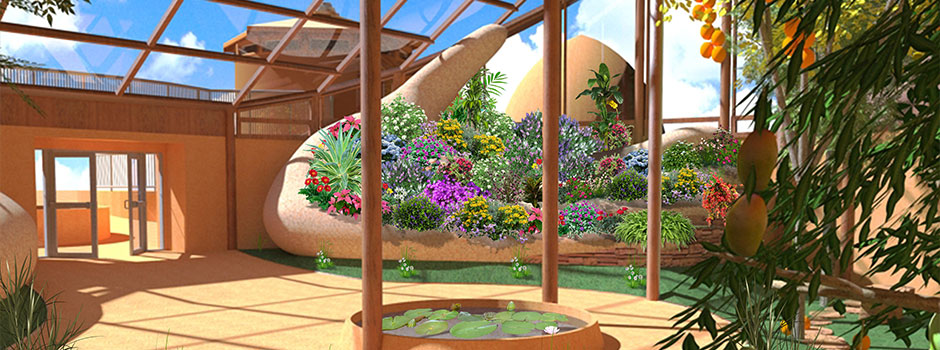
Tropical Atrium Planting and Harvesting
This page is the open source project-launch blueprinting page specific to the free-sharing and global collaboration regarding the One Community Tropical Atrium planting and harvesting details. Once we are funded and building this component we will add videos and additional links on this page including specifics related to our growing and planting experience with the different plants, on-going harvesting tips and yields, links to the best places to purchase plants and seeds, time-lapse photography of everything growing and evolving, and more. The Tropical Atrium is a foundational aspect of our botanical garden model and the center of the Earthbag Village (Pod 1). The complete open source portal can be found on this page: Tropical Atrium Open Source Project-launch Blueprinting Hub.
The following links will take you directly to the following information on this page:
- Planting Overview
- Ways to Contribute
- Consultants for the Page
- Understanding This Structure
- Plant Details
- Harvest Projections for this Structure
- Tropical Atrium Planting Cost Analysis
- Attracting Pollinators for this Structure
- Addressing Wind Needs for Trees
- Summary
- FAQ
RELATED PAGES
OVERVIEW
The Tropical Atrium will create and demonstrate an aesthetically pleasing and functional multi-purpose facility that will serve as a tropical fruit production facility combined with multi-purpose recreational use that will easily invite members of the community/village/city to want to spend time in this space. Internal temperatures and humidity will be maintained between 60-90 degree F and 40-70% humidity respectively.
Central Atrium for the Earthbag Village by One Community – Created by Gilberto Martini de Oliveira
This page shares the complete planting plan and plant details for this structure. Here is the overview image and you can click these links to be taken to the related sections on this page:
VINES & CLIMBERS | HERBS | CREEPERS/FLOWERING CREEPERS | GRASSES
SUCCULENTS | FRUIT-PRODUCING TREES/PLANTS | FLOWERS
WAYS TO CONTRIBUTE TO EVOLVING THIS SUSTAINABILITY COMPONENT WITH US
SUGGESTIONS ● CONSULTING ● MEMBERSHIP ● OTHER OPTIONS
CONSULTANTS ON THIS PAGE AND THE PLANTING PLAN DESIGN
Bear Stauss: Horticulturalist and Landscape Design/Recreation Area Management Specialist
Devin Porter: 3D Graphics Design Specialist (DevinPorter.com)
Diogo Rozada: Civil Engineering Student specializing in Hydraulics
Douglas Simms Stenhouse: Architect and Water Color Artist
Erika Yumi Tamashiro: Architecture and Urban Design Student
Ron Payne: Mechanical Engineer and HVAC / Thermal Designer
Shadi Kennedy: Artist and Graphic Designer
UNDERSTANDING THIS STRUCTURE
For purposes of this planting and harvesting plan, the planting plan is divided into two halves called “The South 180” and “The North 180.”
THE SOUTH 180
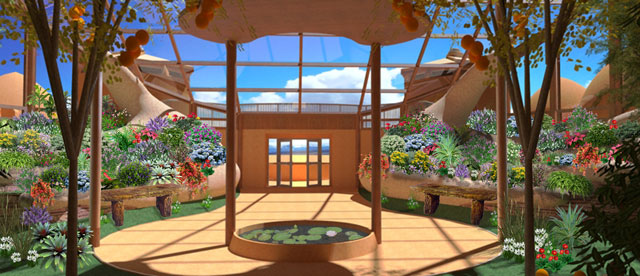
Tropical Atrium view looking South – “The South 180”
As one comes in from the north entry and looks to the south from the platform, you will view over 90% of the interior plantings; the unseen will be a few trees and part of the wall directly behind you. The HANDS will be visible and you will see tree plantings and rock forms that demonstrate various color, texture, density, and tone. Beyond aesthetics, many of the plantings will offer fruit and herbs for medicinal and culinary uses. Some annual plantings will be traded out over time and that will incorporate change as we experiment with humidity, light, and temperature variations to determine which perennial selections are best suited to the environment. These adaptations will be shared with everyone as we learn through the process.
South 180 Terraces
“South 180” terraces created by the fingers will be utilized for growing herbs, ornamental clump grasses, flowers, and other pollinator attractants. The terraces created by the hands will be planted so the index finger has all full-sun low-growing plants, with the exception of the climbing vine bougainvillea and the 2′ + Ocimum sanctum (Holy Basil “Tulsi”) that will be planted in front of the thumbs. Interspersed rocks and their intersecting lines will be softened by the low creepers and some of the plantings will “appear to grow out of the rocks,” a theme that will be carried out at multiple sites throughout the Tropical Atrium. The following eight ground covers, five of which are considered to be good bee attractants, are all 1-3″ in height and will be utilized on the index fingers: Stepping Stone thyme, Minus thyme, Wooly time, Corsican mint, White Creepy thyme, Mother of Thyme, Doone Valley thyme, and Bressingham thyme.
With each succeeding terrace there will be a shadow cast approximately 1′ wide, depending on the time of day and the season. At the winter solstice the shadow will be at its maximum depth and at the summer solstice at its minimum depth, with gradations in between. At some point during the day, most of those shadow zones will receive some direct sun. The planting plan will compensate for shading by placing taller semi-shade tolerant plants, such as Sweet Woodruff, Vinca major, Vinca minor, Vinca minor “Variegata”, Ajuga, and ornamental clump grasses within that shadow zone up against the stone fingers (yet maintained below grade of the above terrace to prevent sun blockage) with their heights varying from 6-24″ and keeping below the above terrace. Therefore, we will have in the first foot of the terrace shadow zone those plants; the remaining 3′ of the terrace will be planted to gradually decreasing heights of plants so as to not block much of the sunlight. These will include other low lying plants such as Orange-Scented thyme, Variegated peppermint, Pennyroyal, Creeping rosemary, Pink Chitntz thyme, Red Creepy thyme, and Roman chamomile (generally in the 4-8″ height range). Most selections are bee and butterfly attractants which are necessary for pollination of our fruiting tree species.
South 180 Fingers
On the actual fingers (which is the leading edge of each terrace) we will have ground covers that grow from parts of the fingers and cascade over the edge, most of these 1-3″ in height. For design and aesthetics, some intermittent planting of taller plants will occur in that 3-foot zone, but not enough to substantially affect the plants directly below because of the spacing and the sun’s daily trajectory path; these will include flowers and ornamental clump grasses. The overall layout of the fingers will be informal and pleasing to the eye and enhanced by the color, hue, texture, and height variations. Ideally we want to regulate our temperature in the TA via venting and thermal mass storage (see also Adapti. Maximum temperatures of 75-85 F is suitable for most of the fruit trees and our objective is not to exceed that for prolonged intervals. Temperatures in excess of that can be tolerated for short durations. Mulching will play a significant role in all our plantings to reduce competitive weeds, reduce watering requirements, heat retention, and aesthetics. We will use wood chips, compost, and gravel (in a few select areas). Large rocks will be arranged in natural formations as part of our interior landscape, acquired on site and installed during the process – therefore, they are not located specifically on the drawings.
South 180 Hands
The “HANDS” will be planted in a rock garden theme and various rocks will be placed throughout the hand terraces for aesthetics and thermal mass. Irrigation of this area is recommended via buried soaker hoses/drip system and will be switched over to recycled water as it becomes available. With the quantity and proximity of the HANDS plantings, it is not practical to irrigate this area with a standard gray water system. If we run a drip system, the installation can be laid out above ground at the intersection of the horizontal and vertical planes of the terraces and disguised with rocks and plantings that will be part of the normal landscape. Eventually, the gray water from the adjacent showers will be utilized on the lower 180 North fruit tree and vine plantings while the excess will be discharge to the north for further cleansing. If we attain success with our cleansing ponds we will have 100% recycled water available for irrigation. We will also attempt to recapture the heat from the showers and recycle that into the tropical atrium.
Click these links to visit the associates sections on this page:
VINES & CLIMBERS | HERBS | CREEPERS/FLOWERING CREEPERS | GRASSES
SUCCULENTS | FRUIT-PRODUCING TREES/PLANTS | FLOWERS
THE NORTH 180
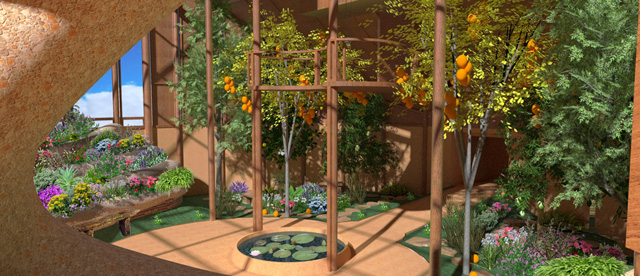
Tropical Atrium View Looking Northwest – “The North 180”
The “North 180” will serve as a tri-functional space. The space will be dominated by the Fruit Demonstration Project where we will demonstrate the feasibility of growing tropical fruits (in a semi-arid high desert region) within the Tropical Atrium. We will begin growing the following fruit: water (wax) apples, lemons, papayas, pineapples, mangos, bananas, avocados, passion fruit, kumquats, and some other dwarf fruiting species as space allows. Secondly, the yoga instructor’s platform will be here and this and the adjoining lowest tier will also serve as a casual classroom area for presentations, interactive discussions, movies, conversation, music, etc. The third function is as a passive recreation area with several scattered benches and two separate stone walkways.
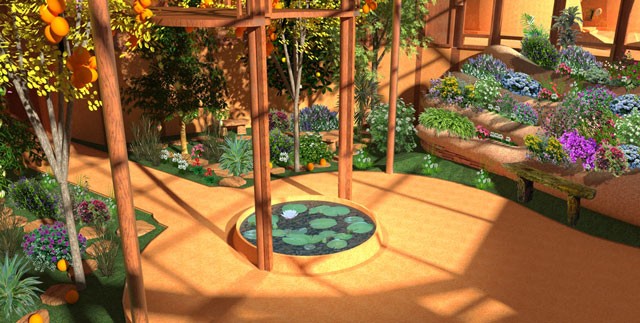
Tropical Atrium View Looking Northeast – “The North 180”
An obvious offshoot of this is to create a self-guided arboretum with information available on all plantings. This is an ideal setting as it will be nestled within the fruit trees and planted with various ground covers and ornamental clump grasses, to enhance the overall atmosphere. Low-lying ground covers will randomly grow between the rock pathways, under some of the trees, and as border plantings. Flowering vines on the north wall will provide a nice backdrop and will be selected from these 7 selections: Stephanotis floribunda, Clerodendrum splendens, 4 different varieties of Clematis, and Passiflora edulis. Most of these are both butterfly and bee attractants. Growing any of these on the standard ceiling of the North 180 TA may be limited by indirect sunlight, but will grow very well in direct sun and some partial shade in the TA, Walipinis and Aquapinis.
Click these links to visit the associates sections on this page:
VINES & CLIMBERS | HERBS | CREEPERS/FLOWERING CREEPERS | GRASSES
SUCCULENTS | FRUIT-PRODUCING TREES/PLANTS | FLOWERS
IMPORTANT CONSIDERATIONS
Shipping dates have to be coordinated as many companies will ship bareroot stock in the spring before trees leaf out. Be certain the timing is coordinated with all parties involved, especially if you have no storage facility to hold over plants. If you do not have the storage capacity, have the ground ready for planting and a crew available to plant immediately upon their arrival. Holes should even be pre-dug if the shipment is not container stock.
PLANT GROUPING
Consider plant groupings with similar water requirements as well as groupings for attracting bees. We can transplant some native species from the property near the TA, as these would make good bee attractants to the immediate area. If we are lacking in pollenizers, we can add to them from a list of flowers included in this narrative, beginning with selection 50 below. If we can locate a few hives so as not to interfere with normal activity and keep the pollinators around, we may get them inside, perhaps, by opening side panels and luring them with red-colored sugar water into the TA – this would be inviting to bees, butterflies, and hummingbirds too. The success of our fruit growing demonstration project is highly dependent on pollination. See additional info below in the section titled “Attracting Pollinators.”
GROUND COVERS AND CREEPERS
These will be planted between stones and along walkways in the TA and some on the northern edge of terrace soil lines, growing out over the rock fingers and trailing downward. Some of the rocks comprising the fingers will be slightly separated and filled with soil to allow rooting of succulents and a few ground covers – this will provide attractive accent plantings directly into the fingers. Creepers will also be placed in the Walipinis and Aquapinis.
Both the NE & NW quadrants of the “North 180” will be planted to fruiting species and will contain an oblong rock pathway with various groundcovers. The exact planting locations will be experimental initially, until we establish the sun/shade patterns according to the amount of shade cast by the trees. It will be easy enough to adjust as necessary as we will plant both sun tolerant and shade/semi-shade tolerant species along the pathways and within the rock pathways.
TROPICAL ATRIUM PLANTING PLAN
The index or reference number preceding each plant name is cross referenced to the planting cost analysis price list as well as the planting layout map above. The planting plan is not a firm declaration and will be modified on site (with ongoing updates here) after all plants are preliminarily sited. Due to the quantities of plants, for ease of clarity and understanding, not every individual plant is listed on the planting layout map.
Note: Some of the attached photos (though most are) are not the exact cultivar but are similar to what will be planted. They are provided to give you a general understanding of the appearance of the plant. Also, we always appreciate receiving feedback from those who have any additional information about these plants, particularly if they disagree with what we have written or have additional cultural tips to share.
VINES AND CLIMBERS
There are six climbers we have selected for planting on the back wall of the North 180 stretching from west to east. They have all been selected for their varying flower colors, foliage, fragrance, and shading ability. The vines will grow up the trellised walls to provide a blanket of greenery among the different flower colors. We will insert rebar into the stone wall to provide the sturdy and permanent support all of these vines need. In addition to this, we’ve chosen Bougainvillea for the thumbs.
#1T :: Bougainvillea
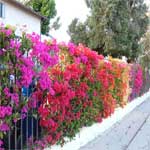
Bougainvillea are thorny, woody vines with numerous radiant colors. These South American native plants are drought resistant and thrive in lots of sun. Bougainvillea is an extremely versatile plant that can grow up to 20 feet in any good soil with drainage. They are a natural choice for coastal regions due to their high salt tolerance and can also be used as a houseplant or hanging basket plant in cooler climates.
PLACEMENTS
We have chosen to place this plant at the base of the thumbs for its tolerance to dry conditions, its brilliant colors, and for possible shading and heat reduction (if necessary) of the plants on the fingers. This plant will be tested on an experimental basis as it requires a minimum temperature of 60 F. With the high altitude and uncertainty of maintaining this minimum temperature on winter evenings, Bougainvillea will be challenged to flourish. At worst, we are hoping it only goes into a semi-dormant state and recovers when minimum temperatures remain at 60 F and above.
CULTURAL CONSIDERATIONS
- Will not flourish if overwatered
- Look their best when kept at 18-20’
- A 6-8-10 fertilizer is preferred over a 12-12-12 or a 20-20-20
- Requires minimum temps of 60 F and at least 5 hours of daily sun
- Bougainvillea are heavy feeders, requiring monthly fertilization during blooming season
- Nitrogen and phosphorus are critical for flowering, excessive fertilizer inhibits blooming
- Root systems are extremely fragile – use caution when removing from pot for replanting
- Prune when branches deter from overall shape or jeopardize structural integrity of plants
PLANTING GUIDELINES
We will receive this plant as a rooted cutting. To plant, simply dig a small hole ⅓ larger than the current rooted ball in a site with excellent drainage, the roots do not like to be soggy. Use a half and half mix of native soil and good organic soil. A small amount of phosphate added to the hole will encourage blooming and is good for the overall health of the plant. NEVER disturb the root system when planting and keep the root ball about 1/4” -1/2” above the surrounding soil so when it settles it will be at ground level. Excess soil on the root ball can lead to crown or root rot. Initially water the plant well, then again in 3-4 days, but never overwater bougainvillea.
ADDITIONAL INFORMATION
Wikipedia – Bougainvillea ● How to Grow Bougainvillea Plants
#43T :: Stephanotis floribunda (Madagascar Jasmine)
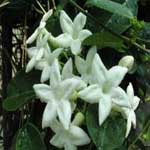
Stephanotis floribunda, a broadleaf evergreen native to Madagascar, is known for its jasmine scented, white showy flowers. This tropical twining woody climber reaches 12-20 feet tall with a spread of 3-6 feet. The attractive dark green leathery foliage and intensely fragrant tubular flowers of the Madagascar Jasmine are commonly used in bridal bouquets and make excellent houseplants as well.
PLACEMENTS
Madagascar Jasmine, an evergreen climber, will be planted at the rear wall of the northwest quadrant on both sides of #45, a deciduous vine. This location was chosen because the deciduous climber may lose their leaves for half of the year depending on lighting during the short daylight periods of the winter months and the Madagascar Jasmine will keep the surrounding area green while still allowing the available light to hit the back wall and provide additional thermal mass. If even more thermal mass storage is needed, then additional pruning of the Madagascar Jasmine will be applied to the most beneficial areas. The flowers of this plant will also help to further attract pollinators for the fruit trees.
CULTURAL CONSIDERATIONS
- Thrives in well-drained soil
- No serious insect or disease problems
- Watch for scale and mealy bugs on indoor plants
- Blooms in summer, prune after blooming in late summer or fall
- Flower production enhanced if plant is given a rest period in winter
- Minimum temperatures should be in the 55-60 F range, preferably the latter
- Can tolerate full sunlight to partial shade and has a medium maintenance level
- Tolerates drought, but water regularly in the growing season, reducing water in winter
- Feed with high phosphorus fertilizer in spring to promote flowering, rest plant in winter
PLANTING GUIDELINES
Madagascar Jasmine will be received as a small potted plant. When transplanting, loosen any rootbound roots and place in a hole with a handful of rich organic compost, positioning at the same level as when in the previous pot and water generously. With any of the climbers, it is worthy of consideration to confine the roots as some of these can spread readily. This is easily done by planting in a large recessed pot or barrel dug in to ground level.
ADDITIONAL INFORMATION
Wikipedia – Stephanotis floribunda
#44T :: Cleodendrum splendens (Flaming Glorybower)
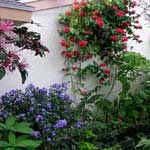
Flaming glorybower is a fast growing evergreen vine native to tropical West Africa. Growing to 12 feet tall, this woody plant climbs by twining up supports or by sending its branches laterally out across the ground. Its bright, showy, red-scarlet flowers form dense terminal clusters attractive to butterflies. Cleodendrum splendens is used as an evergreen screen on a trellis or wall, as a groundcover, or a houseplant.
PLACEMENTS
Flaming Glorybower (like #43) is an evergreen climber that will be planted at the rear wall of the northwest quadrant on both sides of #45. This location was chosen because #45 is a deciduous climber and may lose it’s leaves for half of the year depending on lighting during the short daylight periods of the winter months. Flaming Glorybower combined with #43 (Madagascar Jasmine) will keep the surrounding area green while still allowing the available light to hit the back wall and provide additional thermal mass in the areas exposed by #45. If even more thermal mass storage is needed, then additional pruning of the Flaming Glorybower will be applied as needed. The flowers on this plant will also help attract pollinators for the fruit trees.
CULTURAL CONSIDERATIONS
- Plant does not tolerate frost
- Blooming inhibited if grown in deep shade
- Prefers full sun, but likes shade in hot summer
- Water frequently in summer, sparingly in winter
- Once established, it will do well in drought conditions
- Likes almost any soil condition, but prefers acidic soil
- Blooming period begins after the start of winter and into late spring
- Promote branching and flowers by cutting back prior growth to a suitable pair of buds
PLANTING GUIDELINES
Flaming Glorybower will be received as a small potted plant. When transplanting, loosen any rootbound roots and place in a hole with a handful of rich organic compost, positioning at the same level as when in the previous pot and water generously. With any of the climbers, it is worthy of consideration to confine the roots as some of these can spread readily. This is easily done by planting in a large recessed pot or barrel dug in to ground level.
ADDITIONAL INFORMATION
Wikipedia – Cleodendrum splendens
#45T :: Clematis lanuginosa ‘Nelly Moser’ (Nelly Moser Clematis)
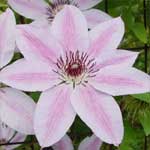
Clematis lanuginosa ‘Nelly Moser’ is a medium-sized, early flowering vine, reaching heights to 10’. Its showy, flattish flowers have eight mauve-pink sepals, each with a distinctive cherry red stripe and red stamen giving it a pinwheel look. Nelly Moser can be found climbing a wall, trellis, fence, arbor, porch or lamp post. This deciduous climber flowers in late spring to early summer and early autumn.
PLACEMENTS
Nelly Moser Clematis is a deciduous vine that will be planted at the midpoint of the rear wall of the northwest quadrant between numbers 43 & 44. It was chosen for this location because any fall/winter leaf loss that it experiences will lead to an increase of thermal mass storage from added sunlight hitting and heating the back wall. The flowers of this plant will also help to further attract pollinators into this structure.
CULTURAL CONSIDERATIONS
- No serious insect or disease problems
- Prefers a fertile, well-drained soil; intolerant of heavy clay soils
- Best grown in partial or full shade; flower color fades in strong sun
- Most clematis prefer full sun, but this cultivar is more shade tolerant than most
- Does not require extensive pruning indoors, but a general spring pruning is advisable
- Shade roots with a mulch or selection of annuals/perennials to retain adequate moisture
PLANTING GUIDELINES
Nelly Moser Clematis will be received as a small potted plant. When transplanting, loosen any rootbound roots and place in a hole with a handful of rich organic compost, positioning at the same level as when in the previous pot and water generously. With any of the climbers, it is worthy of consideration to confine the roots as some of these can spread readily. This is easily done by planting in a large recessed pot or barrel dug in to ground level.
ADDITIONAL INFORMATION
Wikipedia – Clematis lanuginosa
#46T :: Clematis armandii ‘Snowdrift’ (Snowdrift Clematis)

Snowdrift Clematis is an evergreen vine appearing as masses of tiny 4-petaled white propellers and emitting a sweet spring scent of honey and almonds. Reaching 10-25 feet in height and 5-8 feet in width, this fast growing plant is excellent to use as a climber or as a groundcover. This clematis has breathtaking blooms that stand out brilliantly against glossy, leathery deep green foliage.
PLACEMENTS
Snowdrift Clematis, an evergreen climber, will be planted at the rear wall of the northeast quadrant on both sides of #48, a deciduous vine. This location was chosen because the deciduous climber may lose their leaves for half of the year depending on lighting during the short daylight periods of the winter months and Snowdrift Clematis will keep the surrounding area green while still allowing the available light to hit the back wall and provide additional thermal mass. If even more thermal mass storage is needed, then additional pruning of the Snowdrift Clematis will be applied to the most beneficial areas. The flowers of this plant will also help to further attract pollinators for the fruit trees.
CULTURAL CONSIDERATIONS
- Disease and pest resistant
- Thrives in a moist well-drained clay/normal/loamy soil
- Requires full sun/partial shade; heat and humidity tolerant
- Intense fragrance and blooms prolifically March and into June
- In cold regions, best planted in a sheltered area to retain evergreen foliage
- Requires spring removal of dead branches, summer pruning after blooming for shaping
PLANTING GUIDELINES
Snowdrift Clematis will be received as a small potted plant. When transplanting, loosen any rootbound roots and place in a hole with a handful of rich organic compost, positioning at the same level as when in the previous pot and water generously. With any of the climbers, it is worthy of consideration to confine the roots as some of these can spread readily. This is easily done by planting in a large recessed pot or barrel dug in to ground level.
ADDITIONAL INFORMATION
#47T :: Clematis armandii ‘Apple Blossom’ (Apple Blossom Clematis)
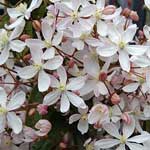
‘Apple Blossom’ is a superb apple-blossom pink evergreen clematis and a vigorous climber that will reach 20 feet in height and spread to 10 feet in width. This hardy China native is known for it’s prolific blooms and intoxicating vanilla scent. It is the recipient of the Award of Garden Merit from RHS (Royal Horticultural Society) and is excellent as a climber or a groundcover.
PLACEMENTS
Apple Blossom Clematis (like #47) is an evergreen climber that will be planted at the rear wall of the northwest quadrant on both sides of #48. This location was chosen because #48 is a deciduous climber and may lose it’s leaves for half of the year depending on lighting during the short daylight periods of the winter months. Apple Blossom Clematis combined with #46 (Snowdrift Clematis) will keep the surrounding area green while still allowing the available light to hit the back wall and provide additional thermal mass in the areas exposed by #48. If even more thermal mass storage is needed, then additional pruning of the Apple Blossom Clematis will be applied as needed. The flowers on this plant will also help attract pollinators for the fruit trees.
CULTURAL CONSIDERATIONS
- Prune after flowering
- Blooms prolifically March and into June
- Thrives in humus-rich, well-drained soil
- Easily propagated by cuttings taken in early summer
- Scale, powdery mildew, rust, wilt and fungal spots may be problems
- Above problems alleviated by excellent drainage and sunny location
- Along coastal areas it prefers full sunlight, but partial shade in warmer zones
- If growing in extreme weather, provide adequate shelter from winds and extreme temps
PLANTING GUIDELINES
Apple Blossom Clematis will be received as a small potted plant. When transplanting, loosen any rootbound roots and place in a hole with a handful of rich organic compost, positioning at the same level as when in the previous pot and water generously. With any of the climbers, it is worthy of consideration to confine the roots as some of these can spread readily. This is easily done by planting in a large recessed pot or barrel dug in to ground level.
ADDITIONAL INFORMATION
#48T :: Clematis ‘Jackmanii’ (Jackmanii Clematis)
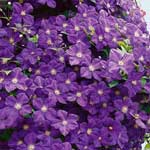
Clematis ‘Jackmanii’ is an all time favorite and famous showy flower, blooming a beautiful velvety purple enhanced by central reddish-purple stripes on each petal. This popular, vigorous clematis vine blooms early-mid summer and again in late summer-early autumn, growing to 10-12 feet tall and 3-6 feet wide. The Jackmanii was produced from crosses made by George Jackman, a prominent nurseryman, in 1858.
PLACEMENTS
Jackmanji Clematis is a deciduous vine that will be planted at the midpoint of the rear wall of the northeast quadrant between numbers 46 & 47. It was chosen for this location because any winter leaf loss that it experiences will lead to an increase of thermal mass storage from added sunlight hitting and heating the back wall. It’s flowers will also help attract pollinators.
CULTURAL CONSIDERATIONS
- Thrives in average, well-drained soil
- Very hardy, even in extremely cold climates
- More shade tolerant than most other clematis
- Grows best when roots are shaded or mulched
- Avoid heavy pruning until plant is well established
- Cut back in early spring to about 1-2 ft strong buds for training into various shapes
PLANTING GUIDELINES
Jackmanii Clematis will be received as a small potted plant. When transplanting, loosen any rootbound roots and place in a hole with a handful of rich organic compost, positioning at the same level as when in the previous pot and water generously. With any of the climbers, it is worthy of consideration to confine the roots as some of these can spread readily. This is easily done by planting in a large recessed pot or barrel dug in to ground level.
ADDITIONAL INFORMATION
Wikipedia – Clematis ‘Jackmanii’
#49T :: Passiflora incarnata (Purple passionflower, Maypop)
 Passiflora incarnata is an herbaceous vine common in the southeastern United States with intricate lavender flowers and fruit. Purple passionflower grows up to 25 feet in a single season, and is among some of the most aggressive garden vines. The name came from the plant’s floral parts which were once said to represent the Christian crucifixion story, each flower part representing a part of the story.
Passiflora incarnata is an herbaceous vine common in the southeastern United States with intricate lavender flowers and fruit. Purple passionflower grows up to 25 feet in a single season, and is among some of the most aggressive garden vines. The name came from the plant’s floral parts which were once said to represent the Christian crucifixion story, each flower part representing a part of the story.
The edible fruit, with few pests and about the size of a chicken’s egg, has a tart, yellowish-orange, unique tasting pulp, with crunchy seeds. It is commonly eaten by animals and songbirds, which help to distribute the seeds. Maypop is also an important larval food for some species of butterfly. It is not as tasty as the more tropical edible varieties, but makes a nice beverage when mixed with other fruits.
PLACEMENTS
This plant, not indicated on the planting plan, will be spotted in to locations in the South 180 where shade may be required for the intense summer sun. Deciduous in nature, it will allow penetration of the winter sun. Beyond shading, it will offer fruit and extraordinary flowers. It also has numerous medicinal uses. This species is a subtropical representative of this mostly tropical family. However, unlike the more tropical cousins, this particular species is hardy enough to withstand the cold down to -4°F (-20°C) before its roots die (it is native as far north as Pennsylvania and has been cultivated as far north as Boston and Chicago). We will plant some of this outside as well for its shading and greening potential.
CULTURAL CONSIDERATIONS
- Cold and heat tolerant
- A good butterfly attractant
- Easily propagated by cuttings or runners
- Once established, fertilizers and watering are completely unnecessary
- Trellising will improve your ability to find the fruits, which fall off when ripe
- Containment of root system is necessary to prevent overrun of your planting area
- Cold hardy varieties (incarnata) freeze back in winter, but grow profusely next season
- Host plant for Gulf Fritillary butterfly, larvae may consume young plants, but grow back
PLANTING GUIDELINES
Maypop will be received as a small potted plant. When transplanting, loosen any rootbound roots and place in a hole with a handful of rich organic compost, positioning at the same level as when in the previous pot and water generously. With any of the climbers, it is worthy of consideration to confine the roots as some of these can spread readily. This is easily done by planting in a large recessed pot or barrel dug in to ground level.
ADDITIONAL INFORMATION
HERBS
#3T :: Thymus serpyllum (Stepping Stone Thyme, Wild Thyme)
Thymus serpyllum (also known as Stepping Stone thyme, wild thyme, or creeping thyme) is a species of plant used both as a spice and for healing purposes. This vibrant green flat plant with tiny leaves can tolerate full sun exposure or partial shade, and thrives with poor-average, well-drained soil. It gives off a wonderful lemony sweet scent that honeybees love. Stepping on the plant releases the fragrance.
PLACEMENTS
This plant is located on the index fingers due to its bee attractant qualities and very low growing habit that will allow full sun to the plantings below. It will be interspersed between the stone on the walkways in the North 180 for aesthetics; by directly meshing the plantings with the stone walkways it will illustrate a smooth transition between the two.
CULTURAL CONSIDERATIONS
- Shipping of thyme plants is generally in the spring
- Harvest leaves when needed after morning dew has dried
- Can be started by seed, but propagation by cuttings preferred
- Thyme plants are susceptible to fungal diseases, avoid over watering
- Thyme will become woody and requires division or replacement about every 3-4 years
PLANTING GUIDELINES: For all Thyme (3T-12T)
We will receive all thyme plants as herbaceous rooted cuttings. If you have purchased rooted cuttings, transplant outdoors after all danger of frost has passed. For best results, space plants 12 inches apart and place a small handful of organic compost into each hole. Plant the starts at ground level and water thoroughly. Once established, reduce watering. Though they can be planted from seed, it is much easier to take herbaceous cuttings from established plants from new green growth. Root cuttings in fine garden soil or other growing medium, misting daily until well rooted and then plant. You can also place the cuttings in a glass of water until rooted and then plant as described above.
MORE DETAILED INSTRUCTIONS: For all Thyme (3T-12T)
Sowing thyme from seed can be tricky. Indoors – sow the tiny seeds on top of the growing medium and cover with a thin layer of soil mix 6-8 weeks before the last frost. Keep moist until germination (14-21 days to germination). Transplant in individual containers when plants have four true leaves. To avoid legginess, pinch off growing tips of upright varieties to make bushier plants. Transplant outside when all danger of frost has passed. Space plants 12 inches apart, in rows at least one foot apart (90-100 days to harvest).
Harvest as needed, in the morning after dew has dried, before flowering in midsummer. The entire plant may be harvested by cutting the plant and leaving about 2 inches above the ground. The plant will recover before the end of the season; however, the plant may not be as winter hardy. Plants generally become woody after 3-4 years and should be replaced.
Preserve and store thyme by hanging small bunches upside down in a warm, dry, dark place. Once dried remove the leaves from the stem and keep whole. Do not crush or grind leaves until ready to use. Store in airtight containers.
The ice cube method, as seen here, (http://www.youtube.com/watch?v=DC83hsJEBnQ) can be used for storing many fresh herbs; while taking it a step further, you might try this (http://www.thekitchn.com/freeze-herbs-in-olive-oil-173648) preservation method.
ADDITIONAL INFORMATION
#4T :: Thymus serpyllum ‘Minus’ (Minus Creeping Thyme)
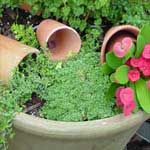
Thymus serpyllum ‘Minus’ is a lovely miniature plant that is beautiful in rock gardens, containers, and can be used as a fragrant ground cover. This slow growing, mat-forming perennial is deer and rabbit resistant and can take light foot traffic. Minus thyme grows 1 inch in height, and spreads up to 18 inches wide. It has overlapping gray-green foliage and looks like moss from a distance, especially since it doesn’t flower.
PLACEMENTS
This plant is located on the index fingers due to its very low growing habit that will allow full sun to the plantings below. It will be interspersed between the stone on the walkways in the North 180 for aesthetics; by directly meshing the plantings with the stone walkways it will illustrate a smooth transition between the two.
CULTURAL CONSIDERATIONS
- Thrives in poor to average, well-drained soil
- Can tolerate full sunlight, and is great in partial shade as well
- Thyme plants are susceptible to fungal diseases, avoid over watering
- Thyme will become woody and requires division or replacement about every 3-4 years
PLANTING GUIDELINES
Same for all thyme – see #3T :: Thymus serpyllum
ADDITIONAL INFORMATION
Plant Oregon – Minus Creeping Thyme
#5T :: Thymus pseudolanuginosus (Wooly Thyme)
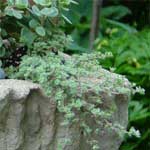
Thymus pseudolanuginosus is a miniature plant that grows 1 inch in height, looks like silver hair from a distance, and grows tiny pink tubular flowers in the summer. It is nice to use in containers, as an edging, or for a ground cover, and its fuzzy texture complements other plants, especially other types of thyme. Although it has a spicy thyme scent it is unsuitable for culinary use.
PLACEMENTS
This plant is located on the index fingers due to its very low growing habit that will allow full sun to the plantings below. It will be interspersed between the stone on the walkways in the North 180 for aesthetics; by directly meshing the plantings with the stone walkways it will illustrate a smooth transition between the two.
CULTURAL CONSIDERATIONS
- Prefers well-drained soil (will rot in moist soils)
- Thrives in poor to average neutral to alkaline soil
- Can tolerate full sunlight, and is great in partial shade as well
- Thyme plants are susceptible to fungal diseases, avoid over watering
- Thyme will become woody and requires division or replacement about every 3-4 years
PLANTING GUIDELINES
Same for all thyme – see #3T :: Thymus serpyllum
ADDITIONAL INFORMATION
Wikipedia – Thymus pseudolanuginosus
#6T :: Thymus praecox arcticus ‘Albus’ (White Creeping Thyme)
Thymus praecox arcticus ‘Albus’ is a tiny, versatile, durable plant that grows over 2 inches in height. It’s lovely white flowers create a snow-like effect. It will cover dry slopes, creep around roses, or work wonderfully as a lawn substitute. Honey bees, birds and butterflies love the flowers of the thyme plant. White Creeping thyme is used in clam chowder and stews, meat dishes, pizza sauce and marinades.
PLACEMENTS
This plant is located on the index fingers due to its very low growing habit that will allow full sun to the plantings below, and its ability to attract bees, birds, and butterflies. It will be interspersed between the stone on the walkways in the North 180 for aesthetics; by directly meshing the plantings with the stone walkways it will illustrate a smooth transition between the two.
CULTURAL CONSIDERATIONS
- Tolerates full sunlight and partial shade
- Thrives in poor to average, well drained soil
- Thyme plants are susceptible to fungal diseases, avoid over watering
- Thyme will become woody and requires division or replacement about every 3-4 years
PLANTING GUIDELINES
Same for all thyme – see #3T :: Thymus serpyllum
ADDITIONAL INFORMATION
SaylorPlants – Thymus praecox arcticus ● Wikipedia – Thymus praecox arcticus
#7T :: Thymus pulegioides (Mother of Thyme)
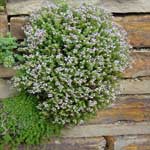
Thymus pulegioides is a tiny plant (2-3 inches) with pretty pink or purple flowers and a pleasant fragrance. It is great to use in containers, as an edging, or as a lovely ground cover or filler between stepping stones. Mother of Thyme is wonderful in marinara sauces, soups, herb vinegars, and sautéed vegetables. This plant helps to clear mucous congestion along with other medicinal uses.
PLACEMENTS
Mother of Thyme is located on the little fingers due to its low growing habit to prevent shading to the stone floor thermal mass at the bottom of the TA. Its natural trailing habit off the face of the stone wall fingers will add a pleasing aesthetic touch and welcome contrast next to the floor area. With its strong ability to attract bees, it will draw them down into the lower region of the TA and encourage pollination of other nearby species, especially drawing them over to the trees in the North 180. It will also be added to the footpath areas of the North 180.
CULTURAL CONSIDERATIONS
- Tolerates full sunlight and partial shade
- Plant in well-drained but relatively poor soil
- To encourage new growth, cut back by one-half after flowering
- Thyme plants are susceptible to fungal diseases, avoid over watering
- Thyme will become woody and requires division or replacement about every 3-4 years
PLANTING GUIDELINES
Same for all thyme – see #3T :: Thymus serpyllum
ADDITIONAL INFORMATION
Pantrygardenherbs – Thymus pulegioides ● Wikipedia – Thymus pulegioides
#8T:: Thymus citriodorus (Doone Valley Thyme)
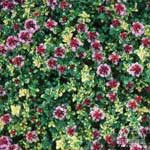
Doone Valley thyme flowers a violet and lavender color with shifting gold, green and variegated foliage depending on the light. It is a heavily scented plant with a pleasing lemon fragrance, growing 2-4 inches. It’s great to use in containers, as an edging, or as cut foliage. This Doone Valley variety is used in clam chowder and stews, meat dishes, pizza sauce, and marinades.
PLACEMENTS
This plant will be used as a filler plant throughout the TA, both on the fingers and the floor of the North 180. Its exact location will be determined near the end of the planting schedule. Its low growing habit, ability to attract bees, and strong lemon scent are the primary reasons for its inclusion.
CULTURAL CONSIDERATIONS
- Tolerates full sunlight and partial shade
- Thrives in poor to average, well drained soil
- To encourage new growth, cut back by one-half after flowering
- Thyme plants are susceptible to fungal diseases, avoid over watering
- Thyme will become woody and requires division or replacement about every 3-4 years
PLANTING GUIDELINES
Same for all thyme – see #3T :: Thymus serpyllum
ADDITIONAL INFORMATION
Wikipedia – Thymus x citriodorus
#9T :: Thymus serpyllum ‘Bressingham’ (Bressingham Thyme)
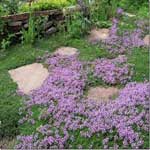
Thymus serpyllum ‘Bressingham’ is a 3 inch miniature plant with light green foliage, bearing profuse amounts of starry pink flowers. This drought tolerant plant is great between paving stones and is appropriate in containers and as an edging. Bressingham Thyme is very ornamental and has a lovely fragrance. It is wonderful in clam chowder and stews, meat dishes, pizza sauce, and marinades.
PLACEMENTS
This plant will be used as a filler plant throughout the TA, both on the fingers and the floor of the North 180. Its exact location will be determined near the end of the planting schedule. Its low growing habit, strong aroma, ability to attract bees and pinkish-purple flowers are the primary reasons for its inclusion.
CULTURAL CONSIDERATION
- Tolerates full sunlight and partial shade
- Thrives in poor to average, well drained soil
- To encourage new growth, cut back by one-half after flowering
- Thyme plants are susceptible to fungal diseases, avoid over watering
- Thyme will become woody and requires division or replacement about every 3-4 years
PLANTING GUIDELINES
Same for all thyme – see #3T :: Thymus serpyllum
ADDITIONAL INFORMATION
Pantrygardenherbs – Thymus serpyllum
#10T :: Thymus fragrantissimus (Orange Scented Thyme)
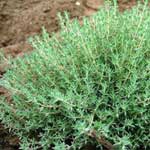
Thymus fragrantissimus has a refreshing orange-mint fragrance, pale pink flowers, and grows 4 inches tall. When used in cooking, the clear orange flavor lingers without the harsh aftertaste of other thymes. Orange thyme is excellent with fish, roasted vegetables, stews and soups. It is popular for its antibacterial and antiseptic properties and used in tea to boost the immune system. Dried flowers are used to repel moths from clothing.
PLACEMENTS
This plant will be used as a filler plant throughout the TA, both on the fingers and the floor of the North 180. Its exact location will be determined near the end of the planting schedule. Its low growing habit, ability to attract bees, and orange-mint fragrance are the primary reasons for its inclusion.
CULTURAL CONSIDERATIONS
- Tolerates full sunlight and partial shade
- Thrives in poor to average, well drained soil
- To encourage new growth, cut back by one-half after flowering
- Thyme plants are susceptible to fungal diseases, avoid over watering
- Thyme will become woody and requires division or replacement about every 3-4 years
PLANTING GUIDELINES
Same for all thyme – see #3T :: Thymus serpyllum
ADDITIONAL INFORMATION
Seedaholic – Thymus fragrantissimus
#11T :: Thymus praecox articus (Pink Chintz)
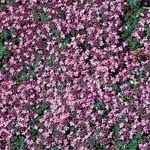
Thymus praecox arcticus is one of the best ground cover thymes because of its vigorous growth habit and pink flowers. It grows 3-6 inches tall, is well adapted for most parts of the country, and is one of the first thymes to bloom. Plant Pink Chintz between stepping stones or somewhere it can trail over a wall or in a mixed pot. It can be used in clam chowder, stews, meat dishes, pizza sauce, and marinades.
PLACEMENTS
This plant will be used as a filler plant throughout the TA, both on the fingers and the floor of the North 180. Its exact location will be determined near the end of the planting schedule. Its low growing habit, ability to attract bees, and pink flowers are the primary reasons for its inclusion, as well as its vigorous growing habit.
CULTURAL CONSIDERATIONS
- Tolerates full sunlight and partial shade
- Thrives in poor to average, well drained soil
- To encourage new growth, cut back by one-half after flowering
- Thyme plants are susceptible to fungal diseases, avoid over watering
- Thyme will become woody and requires division or replacement about every 3-4 years
PLANTING GUIDELINES
Same for all thyme – see #3T :: Thymus serpyllum
ADDITIONAL INFORMATION
Mountainvalleygrowers – Thymus praecox articus
#12T :: Thymus praecox ‘Coccineus’ (Red Creeping Thyme)
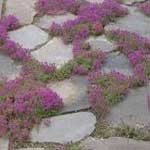
Thymus praecox ‘Coccineus’ grows 3-6 inches tall and makes a beautiful ground cover with it’s deep lavender/red blooms. It is lovely between stones on a path, cascading over walls, in containers, or as an edging. It has a pleasant fragrance and is a butterfly attractant. Red Creeping thyme can also be used in clam chowder and stews, meat dishes, pizza sauce and marinades.
PLACEMENTS
This plant is a filler plant throughout the TA, both on the fingers and the floor of the North 180. Its low growing habit, ability to attract bees, and deep lavender-red flowers are the primary reasons for its inclusion. Aesthetically, it will blend well with the rock walls and stepping stones.
CULTURAL CONSIDERATIONS
- Tolerates full sunlight and partial shade
- Thrives in poor to average, well drained soil
- To encourage new growth, cut back by one-half after flowering
- Thyme plants are susceptible to fungal diseases, avoid over watering
- Thyme will become woody and requires division or replacement about every 3-4 years
PLANTING GUIDELINES
Same for all thyme – see #3T :: Thymus serpyllum
ADDITIONAL INFORMATION
Jeeperscreepers – Thymus praecox ‘Coccineus’
#13T :: Mentha requienii (Corsican Mint)
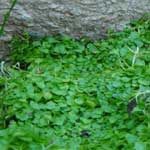
Mentha requienii is an aromatic, mat forming, moss-like groundcover with petite bright green leaves and tiny lavender flowers. It can be used in rock gardens, as a border, in containers, and for mass plantings. It is drought tolerant, resistant to deer and mice, and is great for repelling pest insects. Corsican Mint is used in cuisine, most famously as the flavoring in Crème de Menthe, a mint-flavored liqueur.
PLACEMENTS
This plant is a filler plant throughout the TA, both on the fingers and the floor of the North 180. Its low growing habit, ability to attract bees, and fragrance are the primary reasons for its inclusion. Aesthetically, it will blend well with the rock walls and stepping stones. We have also chosen Corsican mint because it provides a variety of colors, sizes, fragrances, and appearances. Chocolate, spearmint, apple mint, peppermint, and orange mint are a few of the types of mints available.
CULTURAL CONSIDERATIONS
- Thrives in dry to moist soil
- Tolerates full sunlight and partial shade
- Mint seeds don’t always produce the exact variety
- Handling plant may cause skin irritation or allergic reaction
- If you are dividing an existing plant it is best done in the fall
- A good companion plant to brassica plants like broccoli, cabbage, and cauliflower
- Recommended planting method is by root division from an existing plant stock or cuttings
- Extremely vigorous rhizomes, consider root containment via barriers to prevent invasive nature
PLANTING GUIDELINES
We will receive this as a rooted cutting. Mint is an extremely easy plant to grow and is nearly indestructible. To reduce its invasive potential, plant it into pots that can be submersed in the ground. After first watering the plant, break up the roots if it is rootbound. Place the plant in a ceramic pot of good organic soil mix, if possible, as this allows the plant to wick moisture from the surrounding soil. Using a plastic pot eliminates this potential and the plant within the pot will dry out sooner, but if holes are drilled in the plastic pot it will allow some seepage and wicking of moisture to the plant. After transplanting, again water the plant well. Most gardeners, due to the vigorous growth of the mint root system will gladly share their mint plants with you as they are usually glad to give away what they don’t need. Herbaceous cuttings are also easily rooted in water, then planted as described above or if planted in an open garden, space plants 12” apart, in rows 2’ apart. With all mints the spacing is not critical, the further apart you plant the more time it takes to fill in; while closer plantings fill in sooner. To harvest, cut individual leaves any time, once the plants have become established. To dry, spread leaves on a well-ventilated screen in a dry location out of direct sunlight. Store in airtight containers to preserve freshness.
ADDITIONAL INFORMATION
#14T :: Mentha pulegium (Pennyroyal)
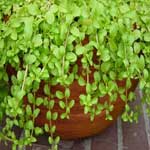
Mentha pulegium, a member of the mint family, is a hardy, ornamental 4-6″ tall, tiny lime green plant with lavender flowers. It is used in containers, rock gardens, as a border, ground cover, and in mass plantings. Pennyroyal is resistant to deer, mice, and insects and it makes a great flea and tick repellant. Crushed Pennyroyal leaves exhibit a very strong fragrance similar to spearmint. Ingestion of pennyroyal is strongly discouraged!
PLACEMENTS
This plant is used as a filler plant throughout the TA, both on the fingers and the floor of the North 180. Its low growing habit, ability to attract bees, and fragrance are the primary reasons for its inclusion. Aesthetically, it will blend well with the rock walls and stepping stones.
CULTURAL CONSIDERATIONS
- Thrives in average to moist soil
- Tolerates full sunlight and partial shade
- Divide and replant every 3 years in fresh compost to maintain healthy growth
- In the fall, mint can be cut back to the ground so that it will be more prolific the next spring
- Extremely vigorous rhizomes, consider root containment via barriers to prevent invasive nature
PLANTING GUIDELINES
We will receive this as a rooted cutting. Mint is an extremely easy plant to grow and is nearly indestructible. To reduce its invasive potential, plant it into pots that can be submersed in the ground. After first watering the plant, break up the roots if it is rootbound. Place the plant in a ceramic pot of good organic soil mix, if possible, as this allows the plant to wick moisture from the surrounding soil. Using a plastic pot eliminates this potential and the plant within the pot will dry out sooner, but if holes are drilled in the plastic pot it will allow some seepage and wicking of moisture to the plant. After transplanting, again water the plant well. Most gardeners, due to the vigorous growth of the mint root system will gladly share their mint plants with you as they are usually glad to give away what they don’t need. Herbaceous cuttings are also easily rooted in water, then planted as described above or if planted in an open garden, space plants 12” apart, in rows 2’ apart. Though mint seeds tend not to reproduce exactly, one can sow seeds indoors in flats 6-8 weeks before the last frost. Sprinkle seeds on fine soil and cover lightly. It takes 14-21 days to germinate. When plants are large enough to handle transplant into larger pots. Transplant outside after all danger of frost is past. With all the mints the spacing is not critical, the further apart you plant the more time it takes to fill in; while closer plantings fill in sooner.
ADDITIONAL INFORMATION
#15T :: Mentha x piperita (Variegated Peppermint)
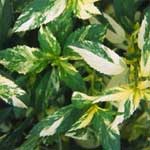
Mentha x piperita is a fragrant plant that flowers purple and grows 4-6″ tall. It is used in containers, rock gardens, as a border, ground cover, and in mass plantings. Variegated peppermint is drought tolerant and resistant to deer, mice, and insects. It is used medicinally in treating indigestion, colds, and morning sickness. It is highly flavorful and used in teas, candies, desserts, and savory dishes.
PLACEMENTS
This plant will be used as a filler plant throughout the TA, both on the fingers and the floor of the North 180. Its exact location will be determined near the end of the planting schedule. Its low growing habit, ability to attract bees and butterflies, and strong fragrance are the primary reasons for its inclusion.
CULTURAL CONSIDERATIONS
- Thrives in dry to moist, average soil
- Tolerates full sunlight and partial shade
- Handling plant may cause skin irritation or allergic reaction
- Great companion for cabbages and tomatoes, helping to keep them free of insect pests
- Extremely vigorous rhizomes, consider root containment via barriers to prevent invasive nature
PLANTING GUIDELINES
We will receive this as a rooted cutting. Root division from existing plant stock, suckers, or cuttings is the recommended method of propagation, best done in the fall. Mint is an extremely easy plant to grow and is nearly indestructible. To reduce its invasive potential, plant it into pots that can be submersed in the ground. After first watering the plant, break up the roots if it is rootbound. Place the plant in a ceramic pot of good organic soil mix, if possible, as this allows the plant to wick moisture from the surrounding soil. Using a plastic pot eliminates this potential and the plant within the pot will dry out sooner, but if holes are drilled in the plastic pot it will allow some seepage and wicking of moisture to the plant. After transplanting, again water the plant well. Most gardeners, due to the vigorous growth of the mint root system will gladly share their mint plants with you as they are usually glad to give away what they don’t need. Simply break off small root clusters and transplant into pots or directly into the ground. Herbaceous cuttings are also easily rooted in water, then planted as described above or if planted in an open garden, space plants 12” apart, in rows 2’ apart. With all the mints the spacing is not critical, the further apart you plant the more time it takes to fill in; while closer plantings fill in sooner. To harvest, cut individual leaves any time, once the plants have become established. To dry, spread leaves on a well-ventilated screen in a dry location out of direct sunlight. Store in airtight containers to preserve freshness.
ADDITIONAL INFORMATION
#16T :: Rosmarinus officinalis cv. ‘Prostrate’ (Creeping Rosemary)
Rosmarinus officinalis prostratus ‘Prostrate’ are Mediterranean native evergreen plants with narrow leaves and edible lavender-blue flowers. This 4-8 inch, aromatic plant is perfect for hanging baskets, draping over a rock wall or incorporating into landscapes. Rosemary is drought tolerant, deer resistant, and repels flies outdoors and moths indoors. It is is great in chicken, pork, lamb, rice, tomato dishes and herb butters.
PLACEMENTS
This plant is used as a filler plant throughout the TA, both on the fingers and the floor of the North 180. Its low growing habit, ability to attract bees, and fragrance are the primary reasons for its inclusion. Aesthetically, it will blend well with the rock walls and stepping stones.
CULTURAL CONSIDERATIONS
- Tolerates full sunlight and partial shade
- Thrives in dry to average, well-drained soil
- Trim for a more lush appearance, after flowering
- In the summer, fertilize potted plants after the flowers have appeared
- Rosemary tolerates partial shade, but the flavor may be weakened if lack of sun
PLANTING GUIDELINES
We will receive this plant as a rooted cutting. Plant in a small hole, 8-12 inch spacing, lined with organic compost, and water after planting; making sure to transplant at approximately the same depth where it was previously planted. Cuttings can be rooted in a container of water and if you root them in late summer, transplant them to another container so they are ready and fully established for next year’s planting.
ADDITIONAL INFORMATION
Greengatefarms – Rosemary ● Wikipedia – Rosemary
#19T :: Ocimum sanctum/tenuiflorum (Holy Basil, Tulsi)
 Ocimum sanctum is an aromatic, multipurpose plant with purple flowers that matures to a height of 12-24″. This sacred plant, according to the Hindus, is considered a “Heal All” plant with numerous medicinal properties. In cooking, holy basil is often added to stir-fry and spicy dishes because of its peppery taste and also used in tea. Additionally, the oil of the plant can be used as a mosquito repellant.
Ocimum sanctum is an aromatic, multipurpose plant with purple flowers that matures to a height of 12-24″. This sacred plant, according to the Hindus, is considered a “Heal All” plant with numerous medicinal properties. In cooking, holy basil is often added to stir-fry and spicy dishes because of its peppery taste and also used in tea. Additionally, the oil of the plant can be used as a mosquito repellant.
PLACEMENTS
This taller plant is located directly in front of the thumbs on the index finger so as not to shade other plants below. It has been selected because of its “heal all” qualities for many common ailments.
CULTURAL CONSIDERATIONS
- Thrives in full sun exposure
- Water regularly, but not excessively
PLANTING GUIDELINES
We will receive this in the form of seeds or as a small potted plant. Tulsi seed is easy to germinate and grow. Sow the small Tulsi seeds in early spring indoors or in the greenhouse for an early start, or sow Tulsi seed directly in the spring or summer garden. Sow Tulsi seeds just under the surface of the soil and press in firmly. Keep Tulsi seed watered and warm until germination, which occurs within 2 to 3 weeks and thin plants accordingly. If transplanting, space plants 24-36 inches apart in a rich soil.
ADDITIONAL INFORMATION
Wikipedia – Ocimum tenuiflorum
CREEPERS & FLOWERING CREEPERS
#17T :: Galium odoratum (Sweet Woodruff)
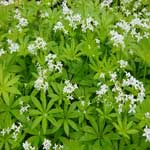
Galium odoratum is a superb ornamental and fragrant star-shaped plant with edible lacy white flowers. This 4-8 inch plant is used as a ground cover in shady areas, in containers, and as stuffing for mattresses. It is also used for flavoring drinks and teas, in perfumes, in potpourri due to its aromatic intensity of the foliage when dried, and for its tonic, diuretic and anti-inflammatory effects. Sweet woodruff is resistant to deer, mice, and insects.
PLACEMENTS
Due to its thriving shade tolerance, this plant will be located near the base of the various finger terraces and underneath the shaded portions of trees. Its low growing habit, ability to attract bees and butterflies, and lacy vanilla scented flowers are additional reasons for its inclusion. Aesthetically, it will blend well with the rock walls and stepping stones.
CULTURAL CONSIDERATIONS
- Best in partial to full shade
- Spreads rapidly and can be invasive
- Needs frequent irrigation in hot weather
- Can grow well in both acidic or basic soil
- Prefers fertile, well drained, evenly-moist soil
- A very cold-hardy plant, tolerating temperatures down to about -25°c
PLANTING GUIDELINES
We will receive this plant as a rooted cutting. Space plants at 6 inch intervals and add a small handful of organic compost in each hole; water after planting.
ADDITIONAL INFORMATION
#18T :: Chamaemelum nobile (Roman Chamomile)
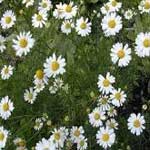
Chamaemelum nobile is a fragrant, low growing evergreen perennial flowering white with yellow centers and growing 6-12″ tall. It is great to use for dried flowers, in containers, and as a ground cover. This popular plant is used to treat health problems such as headaches, colds and stomach disorders. Roman Chamomile is also used in salads and sandwiches, teas, essential oils and aromatherapy.
PLACEMENTS
This plant is used on the leading edges of the fingers and in the North 180 in full sun areas. Its low growing habit, sun tolerance, fragrance, and its ability to blend well with the rock walls and stepping stones are the primary reasons for its inclusion.
CULTURAL CONSIDERATIONS
- Tolerates full sunlight and partial shade
- Thrives in dry to average well drained soil
- Can be aggressive in optimal growing conditions
PLANTING GUIDELINES
We will receive this plant as a rooted cutting. Space transplants 8-12 inch apart, in offset rows 24 inches apart when soil temps reach at least 45 degrees F. If sowing seed directly, sow about 2-3 seeds per inch and thin to clusters of 2 or 3 plants every 12 inches. If you have access to a significant patch of this plant, divide rhizomes and plant directly into a good fertile soil mix.
ADDITIONAL INFORMATION
Wikipedia – Chamaemelum nobile
#20T :: Vinca minor (Lesser/Dwarf Periwinkle, Creeping Myrtle)

Vinca minor flowers a purple, blue, or white color depending on the cultivar, and matures to a height of 6″. It is an excellent spreading evergreen groundcover with dark green foliage, is drought tolerant, and loves shade. This plant is known as periwinkle due to it’s tiny blue-purple flowers. Lesser periwinkle blooms in late March/April, has medicinal uses and is popular for it’s resistance to deer.
PLACEMENTS
This plant will be used as a filler plant throughout the TA, both on the shaded areas of the fingers and the floor of the North 180. Its exact location will be determined near the end of the planting schedule. This plant has been selected specifically for Its drought and shade tolerance, low growing habit, vigorous growth, and flowers. Aesthetically, it will blend well with the rock walls and stepping stones.
CULTURAL CONSIDERATIONS
- Can withstand variable soil conditions
- Thrives in partial shade with ample moisture
- New roots form where stems touch the ground
- Clip well-established plantings to promote new growth
PLANTING GUIDELINES
We will receive this as rooted cuttings. Space transplants 18 x 18 inches and consider physical barrier containment to avoid over spreading. Water thoroughly after planting. Once established, we will provide as many plants as is required via cuttings or root division.
ADDITIONAL INFORMATION
#21T :: Vinca minor ‘Variegata’ (Variegated Common Periwinkle)
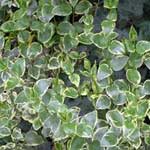
Vinca minor is an evergreen perennial that displays a profusion of lilac blue flowers with dark green glossy leaves and creamy white edges. It’s a terrific groundcover for flower beds, great for firescaping, steep slopes, very wet areas, and woodland gardens. Variegated common periwinkle is deer and rabbit resistant, blooms during the spring, and grows 6-8 inches tall, spreading wider.
PLACEMENTS
This plant will be placed at the base of the little finger terrace specifically for its tolerance to shade and its ability to withstand sun as well. With the sun’s arc, this area will receive both sun and shade at different times of the day, making any of our three varieties of vinca suitable. It will also be planted under some of the fruit trees in the North 180. The variegated leaves offer white splashes of color to the outer edges of the green leaves for a nice color contrast that goes well with the purple flowers. With its dense growth, it acts as a living green mulch to combat weed problems.
CULTURAL CONSIDERATIONS
- Prune in early spring
- Prefers moist, well-drained soil
- Does well in the same place year after year
- Thrives anywhere from full shade to full sun
- Follow regular watering schedule to establish a deep, extensive root system
PLANTING GUIDELINES
We will receive this as a rooted cutting and it is easily planted in a small hole filled with organic compost, about 18 inches apart. Water thoroughly after planting.
ADDITIONAL INFORMATION
#22T :: Vinca major (Large Periwinkle)
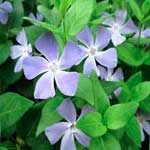
Vinca major is a larger, more aggressive species than V. minor, is less cold hardy, and has broader (and hairier) leaves, larger flowers, and twice as many chromosomes. The blue, funnel-shaped, 5-petal flowers are 1-2 inches in diameter. This bigleaf periwinkle is perfect for covering the soil under trees and shrubs, for controlling soil erosion on shaded slopes, and grows well on the north side of buildings.
PLACEMENTS
This plant is located in the shady parts of the recesses of the second, third and fourth fingers. It will grow well in these locations because of its shade tolerance. It will adapt to the partial sun it receives and is drought tolerant. Its vigorous growth will also be suited to the North 180 section in shaded areas under any of the trees. With its ability to mound up and produce larger purple flowers it will stand out among other plants. This variety of vinca will also be selectively used on the steepest transition slopes between the fingers and the North 180 for soil stabilization, as the roots will aid in preventing erosion of those slopes.
CULTURAL CONSIDERATIONS
- Thrives in moist, well-drained soil
- Prefers shade but full sun tolerant as well
- Weeding and mulching are required on a regular basis
- Provide sufficient water, especially when planting in summer
- Occasionally shear plants close to the ground to encourage new growth
PLANTING GUIDELINES
We will receive this as a rooted cutting. Space plants about 18 inches apart and add a small handful of organic compost, then water well. Once established, root division will easily provides many starts for other planting locations if needed.
ADDITIONAL INFORMATION
#27T-a :: Ajuga reptans ‘Valfredda’ (Chocolate Chip Ajuga)
Chocolate Chip Ajuga is a vigorous low-growing plant that is very easy to care for and provides lots of vibrant color and texture. It typically forms a foliage mat of tiny, shiny, oval leaves which are chocolate with burgundy highlights and grows bluish-purple flowers in the spring. Valfredda is native to Europe, northern Africa, and southwestern Asia. This plant is perfect under shade trees, between stone pavers, or on a steep slope.
PLACEMENTS
Ajuga is positioned to take advantage of the shade in the recesses of the fingers and under the trees in the North 180, between the stone pavers. It tolerates foot traffic better than many plants and the flowers are good butterfly, bumblebee, and hummingbird attractants. Low maintenance and its ability to thrive where other plants cannot, make this an excellent choice for the slopes and shady regions of the TA.
CULTURAL CONSIDERATIONS
- Forms a compact dense mat
- Can be invasive if not contained
- Prefers sandy, well drained soils, but tolerates some clay
- Over watering and excessively heavy soils cause crown rot
- Divide clumps when overcrowded to maintain healthier plants
- Plants grow well in shade, but are more colorful if grown in partial sun
PLANTING GUIDELINES
We will receive this as a small potted plant. Ajuga grows well in shade but will grow in most any type of lighting, including full sun, but when in a water retentive soil, it thrives best. Dig a hole larger than the ball, loosen any compacted roots, drop in a bit of organic matter, cover with soil, lightly tamp the soil, and water. A 20-20-20 or 16-12-10 liquid fertilizer can be used at planting. Mix a tablespoon/gallon of water. Water as needed to keep the soil moist. Space plants about a foot apart. It can tolerate drought, but prefers a damp soil. Space plants approximately 10-15 inches apart.
ADDITIONAL INFORMATION
#27T-b :: Ajuga reptans ‘Black Scallop’ (Bugleweed)
Bugleweed is simply the best Ajuga for midnight-dark foliage, rich blue blooms, and adaptability to varying soils and moisture levels. This stunning, low maintenance plant has large scalloped leaves, fragrant dark violet flowers, is evergreen in mild and warm climates, and very quick to spread. Black Scallop is primarily used as a groundcover; it is very low and mat-forming which deters weeds.
PLACEMENTS
Ajuga will be grown on the 2nd tier of the South 180 close to the terrace base and in the cooler regions of the North 180 under some of the trees. Black scallop has a deep rich dark leaf color that sets it off from ‘Valfredda’. It withstands more sun so it will be positioned in slightly sunnier locations than ‘Valfredda’. A vigorous grower, Ajuga is positioned to take advantage of the shade in the recesses of the fingers and under the trees in the North 180, between the stone pavers.
CULTURAL CONSIDERATIONS
- Can be invasive if not contained
- Thrives in partial shade or full sun
- Prefers sandy, well drained soils, but tolerates some clay
- Over watering and excessively heavy soils cause crown rot
- Divide clumps when overcrowded to maintain healthier plants
PLANTING GUIDELINES
We will receive this as a small potted plant. Ajuga grows well in shade but will grow in most any type of lighting, including full sun, but when in a water retentive soil, thrives best. Dig a hole larger than the ball, loosen any compacted roots, drop in a bit of organic matter, cover with soil, lightly tamp the soil, and water. A 20-20-20 or 16-12-10 liquid fertilizer can be used at planting. Mix a tablespoon/gallon of water. Water as needed to keep the soil moist. Space plants about a foot apart. It can tolerate drought, but prefers a damp soil.
ADDITIONAL INFORMATION
GRASSES
#35T :: Liriope muscari ‘Big Blue’ (Lilyturf)
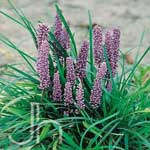
Lilyturf is a tufted, grass-like perennial typically growing 1-2 feet tall and features a clump of strap-like, arching, glossy, evergreen foliage. It’s dark violet blue flower spikes resemble hyacinths and it blooms late summer through fall. The flowers are followed by blackish berries which often persist into winter. ‘Big Blue’ is shade tolerant, resistant to deer/rabbits and good in containers, as an edging/accent plant, and as ground cover.
PLACEMENTS
This is one of eight experimental clump grasses (#’s 35-42) that we will plant in the TA, received as small potted plants. Lilyturf, as a result of its preference for morning sun and afternoon shade, will be planted in the west and northwest portions of the TA to collect morning sun but be shaded by the trees during the afternoon heat.
CULTURAL CONSIDERATIONS
- Divide clumps every 2 to 3 years in early spring
- These plants tolerate more shade than most grasses
- Tolerates heat, humidity and drought once established
- Sun and shade tolerant, best with morning sun and afternoon shade
- Thrives in dry-average and prefers average-slightly acidic and well-drained soil
- A regular watering schedule first growing season will establish a deep root system
- Mow or cut back in early spring to remove old foliage for a more attractive appearance
PLANTING GUIDELINES
We will receive this as a small container plant. Plant 18 inches apart for most applications such as mass plantings, groundcovers, and erosion control. Widen the spacing to at least 2 ft apart if you want distinction between individual clumps. Add a small amount of organic compost to the site when planting and be certain to plant at the same depth as in the container. Water well at time of planting. Cool season grasses are actively growing in spring and fall. These grasses can be divided and transplanted at either time of the year but early spring is best. If you do divide them in the fall, be careful that the freeze/thaw cycles of winter don’t push the plants up and out of the ground.
ADDITIONAL INFORMATION
#36T :: Hakonechloa macra ‘Fubuki’ (Japanese Forest Grass)
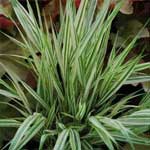
Japanese Forest Grass is a slow spreading grass, growing 8-12 inches high and with graceful arching foliage. It is long-lived, low-maintenance, and highly valued for its various colors, textures and striking flower spikes. This white and bright green (pink in cooler temperatures of autumn) striped grass makes a great edging/accent plant for borders, foundation plantings, and rock gardens.
PLACEMENTS
This experimental grass will be used as a border and accent plant in the North 180 within the confines of the stone walkway in selected partially shaded regions.
CULTURAL CONSIDERATIONS
- Japanese Forest Grass prefers partial shade
- Likes a moist soil, rich in humus, with good drainage
- In northern zones plants will benefit from a layer of winter mulch
- If division is desired it should be done in the spring as new growth develops
PLANTING GUIDELINES
We will receive this as a small container plant. Plant 18 inches apart for most applications such as mass plantings, groundcovers, and erosion control. Widen spacing to at least 2 ft apart if you want distinction between individual clumps. Add a small amount of organic compost to the site when planting and be certain to plant at the same depth as in the container. Water well at time of planting. Cool season grasses are actively growing in spring and fall. These grasses can be divided and transplanted at either time of the year but early spring is best. If you do divide them in the fall, be careful that the freeze/thaw cycles of winter don’t push the plants up and out of the ground.
ADDITIONAL INFORMATION
#37T :: Deschampsia caespitosa ‘Northern Lights’ (Tufted Hair Grass)
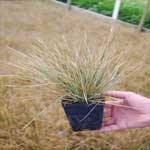
This cool season, deer resistant, slope stabilizing ornamental grass forms medium clumps of tufted green foliage with fine, airy panicles; maturing to a height of 23-25 inches. Tufted hair-grass is cultivated as an ornamental and was used as a thatching material in the past. Although usually avoided by cattle, the tussocks are eaten by horses and rabbits when other food is in short supply.
PLACEMENTS
Deschampsia caespitosa ‘Northern Lights’ is not indicated on the planting plan but is an experimental accent filler grass to be planted sporadically in the North 180 shaded regions under the trees.
CULTURAL CONSIDERATIONS
- Both sun and shade tolerant
- Thrives in average soil, but adapts to most moist soils
- Can be divided when actively growing, preferably in spring
- Cool season grasses tend to look good even as the weather cools
- Cut clumps of grass to the ground in late winter before new shoots appear
- Trimming cool season grasses too harshly can irreparably harm the plant
PLANTING GUIDELINES
We will receive this as a small container plant. Plant 18 inches apart for most applications such as mass plantings, groundcovers, and erosion control. Widen spacing to at least 2 ft apart if you want distinction between individual clumps. Add a small amount of organic compost to the site when planting and be certain to plant at the same depth as in the container. Water well at time of planting. Cool season grasses are actively growing in spring and fall. These grasses can be divided and transplanted at either time of the year but early spring is best. If you do divide them in the fall, be careful that the freeze/thaw cycles of winter don’t push the plants up and out of the ground.
ADDITIONAL INFORMATION
Wikipedia – Deschampsia caespitosa
#38T :: Carex hachijoensis ‘Evergold’ (Sedge)
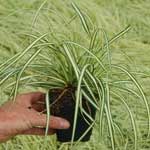
Carex hachijoensis is a highly variegated plant displaying creamy yellow leaves with dark green borders. Maturing to a height of 11-13 inches, this plant is great in containers, as a ground cover, or around ponds and streams. Sedge maintains a good appearance in summer and winter and has a beautiful arching ‘waterfall’ effect pouring out of the pot. It flowers in summer and fall and maintains its foliage in winter.
PLACEMENTS
This plant will be used near a water feature if it is included in our design, or in the partially shaded regions of the North 180, due to its ability to thrive in moist soil conditions.
CULTURAL CONSIDERATIONS
- Thrives in moist soil
- Divide in spring, when actively growing
- Cool season grasses tend to look good even as the weather cools
- This particular sedge withstands drier conditions than most sedges
- Sun tolerant with ideal exposure to morning sun and afternoon shade
- Trimming cool season grasses too harshly can irreparably harm the plant
- Leave their foliage in place until spring and cut them back as soon as the snow is gone
PLANTING GUIDELINES
We will receive this as a small container plant. Plant 18″ apart for most applications such as mass plantings, groundcovers, and erosion control. Widen spacing to at least 2 ft apart if you want distinction between individual clumps. Add a small amount of organic compost to the site when planting and be certain to plant at the same depth as in the container. Water well at time of planting. Cool season grasses are actively growing in spring and fall. These grasses can be divided and transplanted at either time of the year but early spring is best. If you do divide them in the fall, be careful that the freeze/thaw cycles of winter don’t push the plants up and out of the ground.
ADDITIONAL INFORMATION
Wikipedia – Carex hachijoensis
#39T :: Pennisetum setaceum ‘Purpureum’ (Purple Fountaingrass)
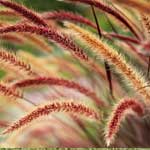
Purple Fountaingrass is a favorite of gardeners everywhere because of its season long, burgundy-red foliage. The arching red foliage makes this plant an exceptional accent plant. This tender perennial is often used in container gardens and will grow to 3 feet or more in height and spreading to 3-5 feet wide. This grass is native to tropical and warm temperate regions of the world.
PLACEMENTS
This plant will be placed in front of the thumbs to receive full sun and also tested in a partially shaded region under the trees in the North 180, as it is known to tolerate both conditions.
CULTURAL CONSIDERATIONS
- Does not tolerate wet, cold soils
- Thrives in full sun and well-drained soil
- Requires little to no care once established
- We may have difficulty obtaining this grass due to state restrictions
- Extremely drought tolerant, does well in full sun but tolerates some partial shade
- Cut back old clumps with browning foliage in late winter to insure fresh foliage in spring
PLANTING GUIDELINES
We will receive this as a small container plant. Plant 18 inches apart for most applications such as mass plantings, groundcovers, and erosion control. Widen spacing to at least 4 ft apart if you want distinction between individual clumps. Add a small amount of organic compost to the site when planting and be certain to plant at the same depth as in the container. Water well at time of planting. Cool season grasses are actively growing in spring and fall. These grasses can be divided and transplanted at either time of the year but early spring is best. If you do divide them in the fall, be careful that the freeze/thaw cycles of winter don’t push the plants up and out of the ground.
ADDITIONAL INFORMATION
Wikipedia – Pennisetum setaceum
#40T :: Festuca glauca ‘Elijah Blue’ (Blue Fescue)

Blue Fescue is a short-lived, low growing, evergreen ornamental grass with silver-blue foliage on tidy, dwarf mounds. This grass forms a porcupine-like tuft with upright to arching blades and is excellent as an accent plant, for edging, or as a groundcover. Festuca glauca is native to central and southern Europe. The cultivar Elijah Blue is salt tolerant and is longer lived than most.
PLACEMENTS
This plant will be spotted in as an accent plant on the South 180 near the end of the planting process. It’s bluish tinge will complement other plants as it receives full sun in a rock garden setting.
CULTURAL CONSIDERATIONS
- Cut back foliage in spring to 3-4 inches
- Plant foliage tends to decline in humid hot summers
- Should be divided and transplanted every 2-3 years
- Tolerant of drought and poor soils, but thrives in well-drained soil
- Endures full sun or partial shade; full sun exposure will intensify the blue color
PLANTING GUIDELINES
We will receive this as a small container plant. Plant 18 inches apart for groundcovers and erosion control and 8-10 inches apart if planted as a mass planting. Widen the spacing to at least 2 ft apart if you want distinction between individual clumps. Add a small amount of organic compost to the site when planting and be certain to plant at the same depth as in the container. Water well at time of planting. Cool season grasses are actively growing in spring and fall. These grasses can be divided and transplanted at either time of the year but early spring is best. If you do divide them in the fall, be careful that the freeze/thaw cycles of winter don’t push the plants up and out of the ground.
ADDITIONAL INFORMATION
#41T :: Schizachyrium scoparium (Little Bluestem)
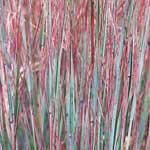
Schizachyrium scoparium is a lovely, tough-as-nails, fine-textured prairie bunchgrass. This North American native offers tight, upright blue tinted leaf blades that turn bold shades of purple, mahogany-red, and orange in autumn. Little Bluestem forms very dense mounds 18-24 inches in height and grows to about 3 feet by September. In winter, the fuzzy white seeds are of particular value to small birds.
PLACEMENTS
This plant will be spotted in at the end. It will be highlighted in the fall by it bright accent colors, making it a nice addition to the sunny South 180.
CULTURAL CONSIDERATIONS
- Excels in sandy soils, dry soils
- Once established, good drought resistance
- Divide clumps every 2 to 3 years in early spring
- For a neat appearance, remove old foliage before new leaves emerge
- Water regularly during the first season to establish a deep and extensive root system
PLANTING GUIDELINES
We will receive this as a small container plant. Plant 18 inches apart for most applications such as mass plantings, groundcovers, and erosion control. Widen the spacing to at least 3 ft apart depending on the look you desire. Add a small amount of organic compost to the site when planting and be certain to plant at the same depth as in the container. Water well at time of planting. Cool season grasses are actively growing in spring and fall. These grasses can be divided and transplanted at either time of the year but early spring is best. If you do divide them in the fall, be careful that the freeze/thaw cycles of winter don’t push the plants up and out of the ground.
ADDITIONAL INFORMATION
Wikipedia – Schizachyrium scoparium
#42T :: Hakonechloa macra ‘Aureola’ (Japanese Forestgrass)
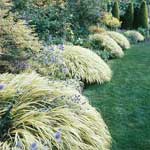
Japanese forest grass is a low-growing, gorgeous plant that offers a perfect mounding habit that sways in a breeze. This variegated selection bears brightly colored golden striped foliage that lights up shady corners. Hakonechloa macra ‘Aureola’ grows 12-18 inches tall and wide and is native to woodland and rocky mountainous areas in Japan, including areas around Mt. Hakone from which this grass received its name.
PLACEMENTS
This plant will be grown in the east and west sections of the North 180 that will allow more sun than shade, but enough shade to retain the golden color of the grass blades.
CULTURAL CONSIDERATIONS
- Divide clumps in spring, when necessary
- If grown in sun, golden foliage generally prevails
- Grows best in a rich, moist soil with partial shade
- A slow growing grass, taking 3 years to reach maturity
- When exposed to more shade, the golden color turns toward a lime green
PLANTING GUIDELINES
We will receive this as a small container plant. Plant 18 inches apart for most applications such as mass plantings, groundcovers, and erosion control. Widen the spacing to at least 2 ft apart if you want distinction between individual clumps. Add a small amount of organic compost to the site when planting and be certain to plant at the same depth as in the container. Water well at time of planting. Cool season grasses are actively growing in spring and fall. These grasses can be divided and transplanted at either time of the year but early spring is best. If you do divide them in the fall, be careful that the freeze/thaw cycles of winter don’t push the plants up and out of the ground.
ADDITIONAL INFORMATION
SUCCULENTS
#26T :: Sedum and various succulents

Sedum and various succulents offer unique textures, an array of colors, and delicate (typically 5 petaled flowers) to a landscape. Their thick, fleshy, water-storing leaves allow them to withstand the heat with little watering. Their deep root systems hold the soil in place, preventing erosion. Most are low growing and suitable for xeriscaping and rock garden plantings due to their unusual and attractive appearance and hardiness.
PLACEMENTS
Though the TA will have a tropical environment, these experimental sedums and succulents will be tested on the fingers and rock outcroppings where the sunny weather will permeate most of the time and possibly create a drier microclimate due to the heat absorbed and released from the various thermal mass rock groupings, also enhanced by the extensive ventilation near ground level that will bring in dry air and tend to lower the humidity level in order for sedum to adapt. Many different types exist and their ability to store water makes them a perfect choice for the driest and warmest regions of the sunniest portions of all the fingers. These plants will be grown on tiers 2, 3, & 4 of the North 180 and at the transitional point of the South 180 where they will receive maximum sunlight. These plant groupings are classified as experimental due to the unknown microclimate humidity levels. If successful, they will make a nice replacement plant for others that may be less adaptive to the TA fingers. We will select a wide variety of these depending on local availability.
CULTURAL CONSIDERATIONS
- Do not require much water
- Prefers a good sandy loam (roots will rot in clay soil)
- Various species have a wide range of cold hardiness
- Plants are drought tolerant and grow best when placed in full sun
- When in bloom, water every few days, reduce after blooms disappear
PLANTING GUIDELINES
These will be received as small potted plants. Prepare a small hole with organic compost about ⅓ large than the rootball. Extract plant from the pot, loosen the roots slightly and plant into the prepared site. Add soil to bring plant to previous level in pot and water thoroughly to establish a good root system. Once established, watering requirements can be reduced.
ADDITIONAL INFORMATION
FRUIT PRODUCING TREES & PLANTS
The “North 180” is the northeast and northwest quadrant of the Tropical Atrium. It will be planted with fruit producing trees and plants, climbers, and other plants. The trees will all be grafted onto rootstocks to ensure good healthy fruit bearing trees. It will also expedite the harvest time from planting to harvest. For example, an avocado planted from seed may take 5-12 years to bear but nursery grown stock may bear fruit within 1-3 years, some are even fruit bearing upon purchase.
#23T :: Ananas comosus (Pineapple)
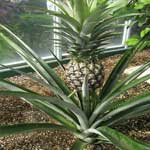
Ananas comosus is a rosette plant with long, narrow leaves bearing sawtooth edges. This popular tropical plant is native to South America and has edible multiple fruit consisting of coalesced berries. It takes about 18 months to grow this juicy, delicious fruit, growing to about 3-5 feet tall and nearly as wide. Pineapples are consumed fresh, cooked, juiced, and preserved, and are found in a wide array of cuisines.
PLACEMENTS
Pineapples will be located on the sunny transition slopes between the North 180 and South 180 zones and on the leading edge of the trees, so as to take advantage of as much sun as possible. These sites will also permit very good drainage, a necessary requirement for pineapples.
CULTURAL CONSIDERATIONS
- Plants are generally pest free
- Pineapples grow in partial shade to full sun, in any soil
- Require about 1 inch of water per week, avoid over-watering
- When plants reach full size they can be induced to fruit with ethylene
- Plants withstand dry periods but for best fruit production need regular water
PLANTING GUIDELINES
It takes about 18 months to grow a pineapple fruit. You will need a greenhouse or a sunny room to get the plant through the winter. Check out the video below, this gentleman’s presentation is both humorous and educational.
http://www.youtube.com/watch?v=Y1klxRnjZOI
Start in early summer and twist the top off the pineapple. Pull off about 1 inch of the lower leaves; you may notice a few small roots where you tear off the leaves.
Place the plant in a 6 inch pot with a good peat-lite potting mix. (Cactus mix is ideal.) The soil should be damp, but not too wet. One of the biggest mistakes people make when growing pineapple and other bromeliads is over-watering. It will take 4-6 weeks for the plant to get a good root system.
Move the plant up to a gallon size pot after about 2-3 months. Use a general purpose water soluble organic fertilizer occasionally, if you wish. By fall, the plant should be ready to move to a 2 gallon pot if the roots are filling the pot. It is important not to jump too soon to a bigger pot because more soil in the pot means a longer time until the soil dries out and wet soil can lead to root rot.
Many people can grow a pineapple plant but cannot get the plant to flower and fruit. If you have this problem, use an apple to induce early flowering. Take an over-ripe apple and slice into 6 wedges. Place the wedges between the pineapple foliage (banana peels will work too).
Cover with a bed sheet for about 5 days. This method works because as apples and other fruits deteriorate, they give off ethylene gas. Ethylene gas is a plant hormone. It will make plants without flowers produce flowers, but be careful. Ethylene gas will also cause plants with flowers to abort them. After 5 days just remove the sheet and remove the apple wedges.
Keep the plant warm all winter and stop fertilizing. Move the plant to a 3 gallon pot in early spring and start fertilizing again. Move to a sunny location. Keep an eye on the center of the plant. Soon, deep down in the center of the plant, you will notice it turning yellow or white. The pineapple flower will emerge soon. The pineapple will have purple flowers that will last about 2 weeks. As the pineapple fruit gets bigger, use 3 bamboo stakes placed around the plant to keep it from falling over if necessary. Move it outside so bees can pollinate the fruit. Poor pollination will result in small fruit.
ADDITIONAL INFORMATION
#28T :: Persea americana (Avocado, Alligator Pear)
 The avocado tree is a tropical, sun loving evergreen that is often referred to as having the most nutritious of all fruits. This tree can grow up to 80 feet tall and produce fruit in the fall, winter and spring, each one different in appearance, size, texture, and taste, and has small green flowers and oval-shaped leaves. The avocado tree originated in central America and is now cultivated worldwide for its oil-rich fruits.
The avocado tree is a tropical, sun loving evergreen that is often referred to as having the most nutritious of all fruits. This tree can grow up to 80 feet tall and produce fruit in the fall, winter and spring, each one different in appearance, size, texture, and taste, and has small green flowers and oval-shaped leaves. The avocado tree originated in central America and is now cultivated worldwide for its oil-rich fruits.
The fruit is botanically a large berry that contains a single seed and has a green-skinned, fleshy pear or spherical shaped body that ranges from 7-20 cm long. This tasty, rich, and creamy fruit is often used in sandwiches, salads, and mashed with spices as guacamole. In other parts of the world avocados are frequently used in milkshakes and other desserts. Persea americana is one of the most nutrient-dense foods available.
PLACEMENTS
These will be grown in the NE quadrant of the TA, near the back wall, where they will receive full sun and minimize their shading of other plants.
CULTURAL CONSIDERATIONS
- Not salt tolerant
- Avoid prolonged periods of root saturation
- May have an irregular crop load from year to year
- Prefers warm climates, without frost and with little wind
- Grows best with cross pollination and air flow between the trees
- Prefers fertile, well drained, moist soil, but can be grown in most soils
- Susceptible to root-rot, stem-end rot, fruit-rot, anthracnose, and algal leaf spot
- Insects: thrips, scale, Chinese rose beetles, fruit flies, mites, twig borers, mealybugs
PLANTING GUIDELINES
Trees will be received as container grafted rootstock, as this ensures a more predictable quality and quantity of fruit. Avocado trees are partially self-pollinating. Planting methods are generally the same for most trees listed here, unless otherwise noted. Dig a hole about a third larger than the root ball received and add some rich compost to the soil. Remove the root ball from the container and loosen visible roots that appear rootbound. Place tree in hole and add soil, water to allow for settling. Continue to add soil so tree is planted at same height as it was in container. Water thoroughly. If you have removed some of the roots, balance out the top with a moderate amount of pruning also.
ADDITIONAL INFORMATION
#29T :: Musa acuminata (Dwarf Cavendish Banana)
 The Dwarf Cavendish is originally from Vietnam and China, and is one of the most commonly planted banana varieties. Although the Cavendish is called a banana “tree” it is botanically classified as an herbaceous plant that grows from a rhizome. The rhizomes can grow several fleshy stalks that resemble tree trunks. This sun loving plant can reach 10 feet tall and produce small, edible bananas after it matures.
The Dwarf Cavendish is originally from Vietnam and China, and is one of the most commonly planted banana varieties. Although the Cavendish is called a banana “tree” it is botanically classified as an herbaceous plant that grows from a rhizome. The rhizomes can grow several fleshy stalks that resemble tree trunks. This sun loving plant can reach 10 feet tall and produce small, edible bananas after it matures.
Each bunch of fruit can yield 150 to 200 medium-size bananas. These bananas are pest & disease resistant, and the fruits range from 15 to 25 cm in length. Although the fruit is smaller than traditional bananas, they’re a great choice. The fruits are eaten raw, used in smoothies, fruit salads and in baking. Bananas are self-pollinators, containing both male and female flowers. The flowers are oval in shape and can be as large as a small football.
PLACEMENTS
These rhizomes will be planted in the NE quadrant in front of the taller trees where they will receive full sun. Others may be spotted in, if room allows, into the NW quadrant in a similar position.
CULTURAL CONSIDERATIONS
- Require at least semi-tropical conditions
- Bananas thrive in full sun and a well-drained soil
- Most varieties grow best in 12 hours of daily light with good air circulation
- If growing indoors, maintain at least 65 F minimum temperature and humidity of 50%
PLANTING GUIDELINES
Rather than sowing seeds, in-ground planting of rhizomes is the preferred and most reliable method for establishing bananas because the rhizomes continue to spread. Plant rhizomes that have adequate roots already growing and plant at the original depth from where they were transplanted. We advise that you water and fertilize bananas at the same time using any type of balanced fertilizer (balanced fertilizer means it has three similar numbers on the label). Bananas are heavy feeders, fertilize very lightly each time that you water with the exception being that you do not fertilize if you are not seeing active growth. After your initial watering do not water again until the soil is dry to a 1/2 inch depth (use your finger to test it). The soil should be a rich fertile soil that is well drained, resulting in more frequent watering. When harvesting bananas, cut down the thick fleshy stock, hang the bananas, and they will ripen progressively. There is no need to plant again as they multiply by spreading rhizomes and you will already have multiple shoots by the time you make your first harvest. With pollination, the flowers drop and the little bananas will form.
ADDITIONAL INFORMATION
Wikipedia – Musa acuminata ● House Plants for You – dwarf banana tree
#30T :: Fortunella margarita (Kumquat ‘Nagami’)
 Fortunella margarita is a slow-growing, shrubby, and compact tree which produces hundreds to thousands of fruits each year. They are believed to be native to China and have been called “the little gems of the citrus family”. The Kumquat tree grows sweetly fragrant, 5-parted white flowers with yellow-orange, oval or round edible fruit. It grows to about 8-15 feet.
Fortunella margarita is a slow-growing, shrubby, and compact tree which produces hundreds to thousands of fruits each year. They are believed to be native to China and have been called “the little gems of the citrus family”. The Kumquat tree grows sweetly fragrant, 5-parted white flowers with yellow-orange, oval or round edible fruit. It grows to about 8-15 feet.
The kumquat fruit is fleshy, thick, not very juicy, has a spicy outer layer and sweet inner layer, and the pulp is scant. Instead of the pulp, the sweetest part of this citrus fruit is the peel and is the only citrus fruit that is eaten skin and all in a raw state. Nagami kumquats can be made into marmalades, preserves, and dried fruits. They are also used in desserts, as a garnish to cocktail beverages, and as an addition to green or black tea.
PLACEMENTS
This tree is not indicated on the planting plan but will be placed, room provided, in the understory beneath the the water apple and avocado trees in the North 180. Pruned adequately, they will receive adequate sun and not shade any other trees behind them.
CULTURAL CONSIDERATIONS
- Drought tolerant
- Requires hot summers
- Pest and disease resistant
- Hardier than most other citrus, to 15-20 F
- This dwarf citrus does great in a container
- Mid-summer blooms give way to fully ripened fruit ready to eat in February
- The Kumquat plant can thrive in full or partial sunlight in sandy or loamy soil
- In other soil types, still bears delicious fruit in great abundance most of the year
PLANTING GUIDELINES
Trees will be received as container grafted rootstock. To plant, dig a hole about a third larger than the root ball received and add some rich compost to the soil. Remove the root ball from the container and loosen visible roots that appear rootbound. Place tree in hole and add soil, water to allow for settling. Continue to add soil so tree is planted at same height as it was in container. Water thoroughly. If you have removed some of the roots, balance out the top with a moderate amount of pruning also.
ADDITIONAL INFORMATION
Wikipedia – Fortunella margarita
#31T :: Citrus x meyeri (dwarf Meyer lemon)
 Citrus x meyeri is a compact, symmetrical tree with shiny evergreen leaves and fragrant white flowers, growing up to 9 feet tall. It is native to China and believed to be a hybrid cross of Citrus limon (lemon) and Citrus reticulata (mandarin orange). The fragrance is almost like a jasmine/citrus blend and the blooms self-pollinate to produce fruit. Long lived and capable of producing fruit for over 30 years, this is a trouble-free citrus tree.
Citrus x meyeri is a compact, symmetrical tree with shiny evergreen leaves and fragrant white flowers, growing up to 9 feet tall. It is native to China and believed to be a hybrid cross of Citrus limon (lemon) and Citrus reticulata (mandarin orange). The fragrance is almost like a jasmine/citrus blend and the blooms self-pollinate to produce fruit. Long lived and capable of producing fruit for over 30 years, this is a trouble-free citrus tree.
The Meyer lemons vivid yellow/orange fruit against its glossy evergreen foliage makes for a great container or outdoor plant. Meyer Lemons ripen over several months, not all at once. They are sweeter than standard lemons and are mainly used in juices, desserts and as a flavoring. The flowers are eaten in ice creams, fritters and jams. The fruit is rich in vitamin C which helps the body fight off infections and prevent or treat scurvy.
PLACEMENTS
These trees are planted as understory in the NW quadrant of the TA, where they will adapt to the partial and full sun conditions of that particular site.
CULTURAL CONSIDERATIONS
- If given organic fertilizer and occasional water it adapts well
- If potted and brought indoors, place it within 6′ of a sunny window
- This tree thrives in partial or full sunlight and in sandy soil conditions
- Even though a self-pollinator, planted in pairs will encourage more fruit production
- The fruit will grow in clusters of about 6, for larger fruit, thin them out to 2-3 per cluster
PLANTING GUIDELINES
Trees will be received as container grafted rootstock, as this ensures a more predictable quality and quantity of fruit. Dig a hole about a third larger than the root ball received and add some rich compost to the soil. Remove the root ball from the container and loosen visible roots that appear rootbound. Place tree in hole and add soil, water to allow for settling. Continue to add soil so tree is planted at same height as it was in container. Water thoroughly. If you have removed some of the roots, balance out the top with a moderate amount of pruning also.
ADDITIONAL INFORMATION
#32T :: Carica papaya ‘Red Lady’ (Papaya)
 Papaya is a large, tree-like plant, with a single stem with spirally arranged leaves confined to the top of the trunk. The lower trunk is conspicuously scarred where leaves and fruit were borne. ‘Red Lady’ is a high-yielding Mexican variety that can produce 50 to 120 fruits per plant each season. A semi-dwarf variety, it grows 10 to 15 feet tall. Under the right conditions, they can bear fruit in about 12 months.
Papaya is a large, tree-like plant, with a single stem with spirally arranged leaves confined to the top of the trunk. The lower trunk is conspicuously scarred where leaves and fruit were borne. ‘Red Lady’ is a high-yielding Mexican variety that can produce 50 to 120 fruits per plant each season. A semi-dwarf variety, it grows 10 to 15 feet tall. Under the right conditions, they can bear fruit in about 12 months.
The papaya fruit is pear-shaped with medium sweet 3 1/2 -4 1/2 pound fruits with deep salmon red flesh and small black edible seeds clustered in the center. It is high in potassium, Vitamin A and C, and also contains papain, an enzyme which helps digestion. Papaya has a sweet and mild flavor (somewhat like a cantaloupe) and is juicy when ripe. It is used in drinks, jellies, salads, desserts, and can be dried and candied as well.
PLACEMENTS
Papaya seeds will be sown on the extreme east and west areas of the TA. Here they will receive adequate sunlight and as a result of their growing habit will not provide significant shade to other plants.
CULTURAL CONSIDERATIONS
- Plant in small groups for pollination
- Papayas need above average watering
- Grow best in full sun and they love heat too
- Do best in rich soil that is high in organic matter
- Papayas are heavy feeders and require regular fertilizing
- The plants are resistant to Papaya Ringspot Virus (PRSV)
- The plant is highly productive and comes into bearing early
- Make sure planting location has good drainage to avoid root rot
- This tree is damaged or killed if temperatures go below 32 degrees
- Pick when there is 1/5 to 1/3 color change in the fruit and then ripen at room temp
PLANTING GUIDELINES
We will purchase whole organic papayas and extract the seed for planting because papaya seeds are very simple to germinate. Sow the seeds about a ½ inch beneath the surface and be certain to cluster plant, selectively retaining the strongest within the clusters. Water after planting and keep mildly moist until germination. In humid tropical conditions, seeds can simply be thrown on the ground and they will grow well on their own. If you have received container plants, transplant as you would any other plant in a well drained soil.
ADDITIONAL INFORMATION
Local Harvest – Red Lady Papaya
#33T :: Mangifera indica (Mango)
 Mango trees are dense evergreens that grow 30-100′ high, with a very wide and fairly symmetrical spreading canopy. Indigenous to Southeast Asia and India, mangoes are now from tropical countries around the world. Beyond their fruit, mango trees make beautiful landscaping trees in warmer regions. In India they are considered to be a sacred fruit and it’s thought that Buddha used to meditate under a mango tree.
Mango trees are dense evergreens that grow 30-100′ high, with a very wide and fairly symmetrical spreading canopy. Indigenous to Southeast Asia and India, mangoes are now from tropical countries around the world. Beyond their fruit, mango trees make beautiful landscaping trees in warmer regions. In India they are considered to be a sacred fruit and it’s thought that Buddha used to meditate under a mango tree.
Mangoes are a fragrant, smooth-skinned, egg-shaped fruit with juicy, flavorful, orange, fibrous, succulent flesh surrounding a large seed. The skin and pit, along with the bark and leaves have been used in folk remedies for centuries. Mangos provide 100% of your daily vitamin C, 35% of vitamin A and 12% of fiber. They are used in smoothies, salads, salsas, chutneys, on fish, chicken, pork, and as a snack.
PLACEMENTS
These trees will be planted in the center and at the back wall of the North 180 of the TA. Here they will receive adequate sun and due to the ceiling limitations we will plant varieties that can be maintained at 10-15 feet in height and nearly as wide. Recently a series of varieties was introduced which provide great fruit on a small tree, the so-called Condominium Mangoes. Several varieties can be pruned to stay short, under 12 feet. Condo Mangoes easily stay under 12 feet without pruning very much, and are even suitable for growing in large pots over 24 inch diameter. Four varieties are available in this series of trees: ‘Mallika’, ‘Graham’, ‘Fairchild’, and ‘Cogshall’. “Carrie” is another likely option. Many different varieties exist so assess them by your local conditions and the space available.
CULTURAL CONSIDERATIONS
- Mangoes surprisingly prefer a low fertility soil
- For ease of harvesting, consider dwarf varieties
- When harvesting the fruit, leave a long stem section
- Some people can have skin allergies to the resin in mango skin
- Phosphorus and potassium (from wood ash) encourage fruiting
- They are medium to large trees but can be kept smaller with pruning
- Mangoes require frost-free conditions, lots of sunlight, and good drainage
- The mango prefers a dry period for blooming, humidity can cause flower loss
- Mangoes grow terminal flowers so encourage lateral branching by tip pruning
- The tree has few insect pests in the US, among these is the mango seed weevil
- Mangos are adapted to a dry season, and can stand considerable drought and heat
- Both the wood and fruit from a mango tree have been used throughout its long history
- Mangos need moisture to develop fruit , but too much rain can cause fruits to be bland
- Because of dense growth, crown pruning is suggested to increase the light into the tree
PLANTING GUIDELINES
Trees will be received as container grafted rootstock, as this ensures a more predictable quality and quantity of fruit. Because they can be prolific, plant mangoes that fruit at different stages so you can extend the fruiting times. Purchase grafted rootstock to expedite fruiting and seek anthracnose resistant varieties. It is best to plant several self-pollinators if you have the space as this will influence your fruit production. Avocado trees are partially self-pollinating. Dig a hole about a third larger than the root ball received and add some rich compost to the soil. Remove the root ball from the container and loosen visible roots that appear rootbound. Place tree in hole and add soil, water to allow for settling. Continue to add soil so tree is planted at same height as it was in container. Water thoroughly. If you have removed some of the roots, balance out the top with a moderate amount of pruning also.Pink flowers are produced in groups and after fertilization mangoes mature and hang down on very long stalks.
ADDITIONAL INFORMATION
#34T :: Syzygium samarangense (Water Apple, Wax Apple)
 Water apple tree, a rich source of nectar for honeybees and butterflies, grows 15-40 feet spreading to 10-30 feet and is a tropical native to Philippines, India, Indonesia, and Malaysia. Various parts of the tree are used in traditional medicine, some possessing antibiotic activity. The wood is reddish, hard, and grows to dimensional lumber size. The flowers are white, 2.5 cm diameter, with four petals and numerous stamens.
Water apple tree, a rich source of nectar for honeybees and butterflies, grows 15-40 feet spreading to 10-30 feet and is a tropical native to Philippines, India, Indonesia, and Malaysia. Various parts of the tree are used in traditional medicine, some possessing antibiotic activity. The wood is reddish, hard, and grows to dimensional lumber size. The flowers are white, 2.5 cm diameter, with four petals and numerous stamens.
The fruits are pear-shaped and have thin, pink skin with crisp white tissue which is slightly aromatic in taste and smell. Common names include water apple, wax apple, love apple, java apple, chomphu, wax jambu, rose apple, bell fruit, makopa, and tambis; ranging in color from white, pale green, red, purple, crimson, to deep purple or even black. The fruit is used in salads and sautéed dishes with a faint compliment to the flavor.
PLACEMENTS
The water apple is placed at the west end, slightly north of the centerline to take advantage of one of the highest points in the TA. This will be the tallest tree in the structure and we will allow it to grow as high as possible, pruning it only for structural integrity and when it reaches the roof. This tree will definitely be an experimental endeavor to test some of the botanical limitations in a highly different micro-climate. Success of growing this species may be challenging.
CULTURAL CONSIDERATIONS
- Pruning is required to limit their size and encourage lateral growth
- Requires regular watering, but not excessively, until well established
- Challenging to grow at higher elevations, will very likely limit fruit production
- This tropical tree likes full sun, adapts to most soil conditions, and is drought tolerant
PLANTING GUIDELINES
Trees will be received as container grafted rootstock, as this ensures a more predictable quality and quantity of fruit. Dig a hole about a third larger than the root ball received and add some rich compost to the soil. Remove the root ball from the container and loosen visible roots that appear rootbound. Place tree in hole and add soil, water to allow for settling. Continue to add soil so tree is planted at same height as it was in container. Water thoroughly. If you have removed some of the roots, balance out the top with a moderate amount of pruning also.
ADDITIONAL INFORMATION
Wikipedia – Syzygium samarangense
FLOWERS

Tropical Atrium View Looking Northwest
#2T :: Celosia argentea (Plumed Cockscomb)
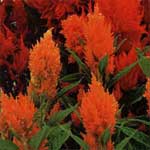
Celosia argentea are brilliantly colored plants that come in three easily distinguishable types: plumes, crests, or spikes. These plants look like plumes of jewel-colored feathers, wrinkly-looking knobs, or elongated cones. They love direct sun, well-drained soil, and range in size from dwarf varieties (4-12 in) to vigorous types (over 3 ft tall). The leaves and flowers are edible and this plant is used medicinally as well.
PLACEMENTS
We have chosen to grow this plant for its summer long accent colors (red, yellow, cream, orange, deep magenta, and pink), minimal maintenance, and the fact that these annuals (sometimes classified as short lived perennials) allow us to add variety and constant change from year to year by rotating various colors in different locations. This plant will grow well anywhere on the lower fingers near the middle of the terraces because it is very tolerant to direct sun.
CULTURAL CONSIDERATIONS
- Look best when massed in large groups
- Will not tolerate wet, soggy soil or shade
- Easily grown from seed and takes 90 days to flower after planting
- Remove central leader to insure adequate lateral branching and height control
- Mites, leaf spots, and stem rot are all preventable by using mulch and a well drained soil
PLANTING GUIDELINES
We will receive celosia seeds for planting. Celosia take about 90 days to flower after starting the fine flower seeds. Celosia seeds can be directly sown into a flower garden or seeded indoors for transplanting later. If planting outdoors, sow Celosia flower seeds after the soil has begun to warm in the spring. We recommend starting them indoors 4 – 6 weeks before the last frost date for your area. The flower seeds need to stay moist and require warm soil to germinate. After germination the soil can dry out before watering again. Sow Celosia seeds early in the season and press them into the soil, but do not cover them. Water thoroughly and keep the soil moist, but not saturated. They perform best when grown in rich soil with lots of organic matter added to the soil. Water celosia regularly during dry periods. Celosia benefits from applications of general purpose fertilizer once or twice a month.
ADDITIONAL INFORMATION
#24T :: Verbena
Verbena contains about 250 species of annual and perennial herbaceous or semi-woody flowering plants growing 12 inches tall and 3-4 inches wide. These fragrant plants have five petal flowers that bloom in white, pink, purple, orange, and red. They are excellent for rock gardens, hanging baskets, and border plantings. Verbena plants have a rich history in herbal medicine, and are used as a remedy for digestive ills and insomnia.
PLACEMENTS
Verbena adds magnificent color to its surroundings and this is the primary purpose for the selection of this annual—to add color and a relaxed ambience to enhance the social atmosphere. We will include multiple varieties in our selections. This plant flowers profusely and adds a couple months of continuous brilliant summer blooms. Seeds will be sown at mid-tier locations and randomly on the front edges of the terraces, overflowing onto the rocks and sometimes trailing over the faces of the terraces of the South 180, taking advantage of the sun.
CULTURAL CONSIDERATIONS
- Thrives in well-drained, average soil
- Seeds can be collected for next year’s plantings
- Drought and heat resistant, tolerating full to partial sun
- Remove dying flower blossoms to encourage continued blooming
- Heavy clay will lead to root rot, so add plenty of compost or leaf mold to lighten your soil
PLANTING GUIDELINES
We will receive seeds for sowing this plant and they are easily started by lightly scattering the seeds on the surface and then tamping them in so about ¼ inch of soil covers them. Use a good rich organic compost mix with your soil. Water after planting and keep soil moist until germination. Thin to about 6 plants per 8 inch pot size. Pinching back leggy plants will lead to a bushier plant.
ADDITIONAL INFORMATION
#25T :: Viola tricolor (Johnny jump-up)

Viola tricolor is an edible small plant of creeping and ramping habit, reaching at most 6 inches tall. It grows in short grassland on farms and wasteland, chiefly on acid or neutral soils. The flowers can be purple, blue, yellow or white and they have been used to make yellow, green and blue-green dyes. Viola tricolor has a history in folk medicine of helping respiratory problems such as bronchitis, asthma, and cold symptoms.
PLACEMENTS
Viola tricolor is a flower that could struggle in the TA due to warm temperatures, but we will experiment in the lower partially shaded areas to test its resiliency. With its fine lacy texture and soft colors, viola tricolor is strictly an atmospheric enhancing plant, like verbena; but its location will differ as it prefers partial shade. This plant will act as an acute accent planting in partially shaded areas throughout the TA. It blooms readily in the spring and will continue into the summer if shadier and cooler conditions exist. Bees are attracted to it and will encourage them to the lower, shadier portions of the North 180 TA.
CULTURAL CONSIDERATIONS
- Thrives in partial shade
- Prefers rich, moist, well-drained soil
- Commonly seen on acidic or neutral soils
- Sow seed early in a cold frame or in spring
- Remove spent flowers by cutting off the tops
PLANTING GUIDELINES
We will receive seeds for planting Viola tricolor. They will be sown randomly under the trees in the North 180 and at the far back of the terraces in shaded regions. These small colorful flowers will continue to re-seed themselves and do so in the direction of partially shaded areas.
ADDITIONAL INFORMATION
OUTDOOR PLANTINGS
Plants planted outside around the Tropical Atrium.
#50T :: Monarda fistulosa (Bee balm, Bergamot)
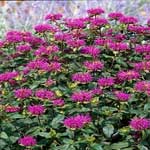
Bergamot is a summer blooming perennial with lavender-pink pompom like blossoms, reaching a height of 3-4 feet. The plant’s bright, tubular blooms attract butterflies, bees and hummingbirds. Enjoyed as a fragrant culinary herb, monarda fistulosa tastes minty and slightly spicy, similar to oregano. Used medicinally as well, this popular plant contains a natural antiseptic which is found in commercial mouthwashes.
PLACEMENTS
Monarda fistulosa is not indicated on the planting plan as it will be grown outside the TA and used to draw bees, butterflies, hummingbirds, and insects to the general area of the TA. It is also a good companion plant to tomatoes, improving the taste and health of the fruit.
CULTURAL CONSIDERATIONS
- Prefers full sun and moist well-drained soil
- Propagate by root division every 3-5 years
- If planted in partial shade, will inhibit flowering
- Slugs can be a serious pest early in the season
- When crushed, the leaves can make an effective insect repellent
- Used as a companion plant around small vegetables susceptible to subterranean pests
PLANTING GUIDELINES
While seed should be stratified briefly before planting (most store bought seed is stratified) if you are collecting your own seed, see this info on stratification:
Canadian Gardening – How to Stratify Seeds
Seed may be cast directly or started in cold frames or greenhouses at soil temperatures approaching 70 °F (21 °C). Randomly cast seed ⅛ inch deep in good quality compost. Germination takes 10 to 30 days. Thin out when large enough to handle, so they are finally 30cm (12 in) apart. Provide additional water if necessary until the plants reach 30cm (10 in).
ADDITIONAL INFORMATION
#51T :: Cleome hassleriana (Spider Flower, Bee Plant)
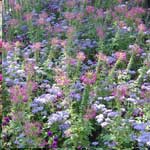
Cleome is a bright annual white/pink/lavender flower known for its exceedingly long seedpods. They develop below the flowers as bloom progresses upward on the stalk to give plants a spidery look, as do the projecting stamens. The flowers, 6-8 inches in diameter and opening simultaneously, grow in airy clusters (racemes) and are perched atop stems that grow 4-6 feet high with a fernlike foliage.
PLACEMENTS
Cleome is not indicated on the planting plan as it will be grown outside the TA and used to draw bees, butterflies, hummingbirds, and insects to the general area of the TA. The hummingbird moth is also drawn to cleome as well; this moth rapidly darts about at twilight and is often mistaken for a hummingbird. Due to its height, these flowers will be planted in the center of islands or at the rear of a wall as a backdrop. Cleome flowers shrug off insect pests and diseases.
CULTURAL CONSIDERATIONS
- Will require staking to prevent toppling over
- Cleome flowers thrive in average garden soil
- A mulch layer of 2-3 inches will minimize watering
- Plants can appear weedy (as seedlings) until established
- Prefers a sunny location and once established does not require a lot of water
- Will reseed itself to the point of being invasive, remove seed pods to prevent reseeding
- Unlike some annuals, these are light feeders, excessive nitrogen results in leggy plants
PLANTING GUIDELINES
We will receive cleome in the form of seeds and sow outside after the danger of frost; germination will take about 10 days. Sow seeds and keep soil damp until germination. Water regularly until well established. Thin plants to 18 inches apart. Blooms mid-late June until frost.
ADDITIONAL INFORMATION
#52T :: Agastache species (Hyssop)
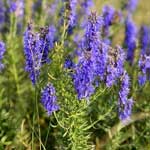
Hyssop carries the fragrance of licorice and are excellent nectar sources for butterflies and hummingbirds. These showy, pungent herb-like perennials are used as seasonings and in teas. They are great for retaining color in late summer and early fall, when many gardens are loosing their brilliance. Most are bushy and sport long, airy spikes of brightly colored, edible, tubular-shaped flowers.
PLACEMENTS
Hyssop is not indicated on the planting plan as it will be grown outside the TA and used to draw bees, butterflies, hummingbirds, and insects to the general area of the TA. They love to drink from these nectar-rich flowers. Hummingbirds are highly attracted to red, orange, and pink-flowered forms, while butterflies, particularly swallowtails, favor the blue-flowered varieties.
CULTURAL CONSIDERATIONS
- Hyssop loves hot weather in the summer
- Agastache is relatively free of pests and diseases
- Grows easily in well-drained, alkaline soil and is adapted to rocky soil
- Some are very drought tolerant but all flower better if they receive supplemental water
- Adapt to richer, organic soils and wetter summers and winters in other northern regions
- Periodic deadheading of the spent flower spikes will extend bloom by preventing seeding
PLANTING GUIDELINES
We will receive hyssop in the form of seed. Plants can be propagated from spring division or sown from seed in early spring at soil temperatures of 55°F to 65°F. Root semi-ripe cuttings in either spring or late summer. The plant’s crown should be planted high and then mulched with crushed gravel to encourage drainage away from the plant and to absorb heat on sunny winter days.
ADDITIONAL INFORMATION
#53T :: Lavendula angustifolia (Lavender)
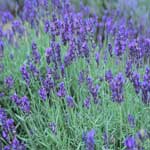
Lavendula angustifolia is a very fragrant mediterranean shrub with beautiful purple, showy flowers from mid-summer into fall. Lavender grows to 1-3 feet in height with an equivalent spread and hardy to -20 F with some varieties. Once established, little maintenance is required. Used for culinary purposes, cut & dried flowers, tea, herbal medicine, and oil. The flowers yield abundant nectar, which make a high-quality honey.
PLACEMENTS
Lavender is not indicated on the planting plan as it will be grown outside the TA and used to draw bees, butterflies, hummingbirds, and insects to the general area of the TA.
CULTURAL CONSIDERATIONS
- Prune to shape in spring after new leaves appear
- Remove faded flowers to promote continued bloom
- Well-drained soils are required, particularly in winter
- Prefers a light, well-drained sandy soil with low fertility and full sun
- Root rot attacks plants grown in high humidity and poorly drained soils
- To combat high humidity, consider using rock instead of organic mulch
- In severe climates, appreciates a sheltered location and winter protection
- Prune back to 8 inches in spring every 3 years to control plant size and to promote new growth
PLANTING GUIDELINES
We will initially receive lavender as seed and cuttings. The cuttings we receive (not what we propagate) the first year will be directly planted into their home locations in the spring. The seed will be planted in the summer and then held over into the winter and planted as individual plants as necessary outside the TA and other areas of the property. We will later use these plants as our source for future cuttings.
ADDITIONAL INFORMATION
Wikipedia – Lavendula angustifolia
#54T :: Mentha suaveolens ‘Variegata’ (Pineapple Mint)
This perennial mint has a wonderful pineapple fragrance and a mild minty taste. Its oval-shaped green leaves, with cream-edged markings and puckered wrinkled texture, make it a highly appealing ornamental and useful edible garden or container herb, growing to 2 feet tall and spreading as wide or more. The spring/summer flowers are tubular upright white or light pink blooms.
PLACEMENTS
Pineapple mint is not indicated on the planting plan as it will be grown outside the TA and used to draw bees, butterflies, hummingbirds, and insects to the general area of the TA. This variety is deer resistant as well and was specifically chosen due to its drought tolerance once it is well established.
CULTURAL CONSIDERATIONS
- Prefers moist, well-drained soils
- Mulch to keep roots cool and moist
- New growth has the strongest fragrance
- If planted in a cold climate, plant in a sheltered region
- Can develop a black fungus on leaves, remove as necessary
- Most mints are companion plants to roses and will deter aphids
- Adaptable to other soils but fairly drought tolerant once established
- This plant should be grown in full sun, though it tolerates some shade
- As plants become woody, remove them and divide to allow younger plants to fill in
- Stems can root if not monitored closely, grow in pots to prevent invasive spreading
- Pinch back stems to encourage new growth and compactness, or harvest regularly
- If plain green stems appear, clip to starting point to discourage reverting to its parent
PLANTING GUIDELINES
We will receive pineapple mint as a small potted plant. Remove plant from container and spread out the roots if root bound. Add a handful of organic compost and plant at same height as in pot and water.
ADDITIONAL INFORMATION
Wisconsin Master Gardener – Pineapple Mint
#55T :: Papaver rhoeas ‘Shirley’ (Shirley Poppy)

The Shirley Poppy is a cultural icon associated with wartime remembrance. This common poppy grows 2-4 feet high and can easily re-seed, a single plant producing up to 60,000 seeds. Used for medicinal, ornamental, and culinary purposes, seeds are edible and from the petals are extracted a red dye. Pick young leaves before bud formation and eat raw, cooked, or as a flavoring in soups and salads.
PLACEMENTS
Shirley poppy is not indicated on the planting plan as it will be grown outside the TA. There are approximately 70-100 various species colored in petals of red, pink, orange, yellow, white and lilac. Shirley poppies are known as a choice selection by honey bees, due to the multitude of stamens which is the primary reason for their inclusion in the outdoor sites near the TA and other selected sites on the property.
CULTURAL CONSIDERATIONS
- Both drought and sun tolerant
- Grows in most any dry soil on its own
- Seed strains are variable and inconsistent
- Seed can be saved but strains are best sown fresh each year
- Potentially poisonous to horses, cattle, and sheep if eaten in large quantities
- Short flowering season (mid-June to mid-July) but stunningly beautiful while it lasts
PLANTING GUIDELINES
We will receive shirley poppy in the form of seed. Seeds will initially be randomly sown outside the TA and at various sites of the property, natural reseeding will occur yearly. For best results, sow new seed when existing strains seem to be growing poorly or you want a variation in color. Sow seeds early, late winter/early spring. They need light to germinate so plant them in the open and tamp down. Thin seedlings early to about 12 inches apart and do not transplant, but carefully pluck seedlings which are too close together, for they have tap roots and will sulk if transplanted. Once the hot weather arrives in July, that is the end of the poppies. At this time you can seed with pansies to have a wonderfully bright follow-up to the poppies in the autumn season.
Allow plants to develop with a minimum of disturbance, keep weeds out. By June, you will see the goose neck, prickly buds and shortly after, gorgeous grey, pearl, salmon, pink, red, orange and blackberry colored blossoms. Poppy seed is extremely small, almost dust-like. Seed this small is best mixed into sand first, before sowing, which helps distribute the seed more evenly onto the surface of the soil. Seed will often come in little, wax paper sachet’s within a traditional paper seed packet. Depending on the seed supplier, you may get only a few dozen of these precious tiny seeds, or nearly a teaspoon full. Most will provide only 30-100 seeds. Mix a few packets of seed together with about 1 cup of dry sand, then carefully pour into a kitchen sieve with holes large enough to allow the seed and the sand to pass through (this will take some practice, to find the perfect sieve). If you find a supplier that provides you with a lot of seed, don’t be tempted to use too much, for a thick sowing is what you want to avoid. About 1/2 teaspoon of seed to 1 cup of sand before sowing a space which is 6 feet long by 2 feet wide will be sufficient. Do not cover the seed, but tamp in place with a brick or a piece of wood. Once the soil surface is tamped down, water in with a spray of water. This is essential now, and until the seedlings are 3 inches tall, for if allowed to dry out in early spring, an entire crop can be lost. Success with Shirley poppies correlates directly to seed strain and seed source.
In mild areas, or in the south, annual poppies prefer being sown in autumn, but in areas where winters are brutally cold and wet, an early spring sowing is safest. March to April is the preferred time to sow outdoors, for poppies can endure cold temperatures and light frosts while seedlings
ADDITIONAL INFORMATION
#56T :: Salvia nemorosa ‘Caradonna’ (Sage)
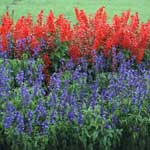
Salvia nemorosa ‘Caradonna’ is an erect, clump-forming perennial that is noted for its dark purple stems and blue-violet flowers. It typically forms a foliage mound to 12 inches tall with medium green leaves possessing a pleasant aromatic fragrance when crushed. In summer, dense terminal spikes of showy violet-blue flowers rise above the foliage to 24 inches tall. Sage typically blooms June to September.
PLACEMENTS
Sage will be grown outside the TA and used to draw bees and butterflies to the general area of the TA for pollination purposes.
CULTURAL CONSIDERATIONS
- Deer resistant
- Tolerates drought, full sun
- Propagate from stem cuttings
- Plants can be divided in spring
- Can grow in average, dry/ medium, well-drained soil
- Prefers moist, gravelly or sandy soils with good drainage
- Remove spent flower spikes to help extend the bloom period
- Plants may flop over as summer progresses, particularly in humid climates
- If so, and they appear unsightly, consider cutting them back to the basal foliage
- Plants may repeat bloom throughout summer, but need regular moisture for this
- No serious insect or disease problems; susceptible to powdery mildew, leaf spot & rust
PLANTING GUIDELINES
We will receive sage as a small potted plant. Remove plant from container and spread out the roots if root bound. Add a handful of organic compost and plant at same height as in pot and water. Space accordingly as they spread 1-2 feet.
ADDITIONAL INFORMATION
#57T :: Viola tri-color (Pansy)
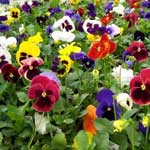
Pansies are a prolific and colorful annual or biennial flower best planted in fall or early spring that come in a variety of colors, including blue, peach, red, purple, white, and yellow. They grow up to 9 inches in height with an equal spreading range. The 1-4 inch flowers (depending on variety) are edible and go well in a salad or as a colorful garnish with most anything. Viola tri-color also has a variety of medicinal qualities.
PLACEMENTS
Pansies will be planted for spring and fall colors outside the TA. They will serve as an accent plant where needed.
CULTURAL CONSIDERATIONS
- Pansies perform well in partial shade to full sun
- Pansies tolerate shade better than many other bedding plants
- Reduce flower size and number of blooms if planted in too much shade
- Newer hybrid versions grow best in full sun, while older types prefer light shade
- Planting the new sun-loving pansies in shade reduces blooming and flower size
- Water thoroughly once a week, and add a monthly 10-10-10 fertilizer (1#/50 sq. ft.)
- Watering rate of 1 inch of water/week in the morning decreases risk of plant diseases
- Prefer mild temperatures, 60 to 65 degree F day and 55-65 night for best performance
- Mulching (2 inches) helps retain soil moisture & reduce weeds for these water-sensitive flowers
PLANTING GUIDELINES
We will receive pansies as a small potted plant. Remove plant from container and spread out the roots if root bound. Add a handful of organic compost and plant at same height as in pot and water. Spacing of 6-10 inches apart will provide an eye-catching mass of multiple colors.
ADDITIONAL INFORMATION
#58T :: Stevia rebaudiana (Stevia)

Stevia rebaudiana, a tender perennial native to semi-humid subtropical regions of Paraguay and Brazil, grows to 30 inches high and 18-24 in wide. It is used primarily as a sweetener and sugar substitute, containing little, if any calories. Stevia extract has been used by native South Americans to reduce weight, treat wound infections, inflammatory conditions, swelling in the legs and as a tonic to treat depression.
PLACEMENTS
Stevia will be planted both inside and outside the TA to determine its tolerance in both areas. Due to its need for cooler temperatures, we may use it as an annual outside.
CULTURAL CONSIDERATIONS
- Avoid wetting leaves during irrigation
- A consistent moisture supply is important for stevia
- Cooler temps and shorter fall days enhance sweetness
- Trickle irrigation is ideal, ensuring consistent moisture levels
- Soaker hoses of recycled rubber are simple and effective also
- Irrigate once or twice a week, whenever rain fails to water plants
- Organic mulch and frequent watering ensure a constant moisture
- Tolerant of most soil types, stevia prefers a sandy loam or loam soil
- Stevia occurs naturally on soils of pH 4-5, but thrives as high as 7.5
- If you don’t have sandy soils, consider raised beds or hills for stevia
- Stevia doesn’t like to dry out, but standing water encourages disease
- Stem cuttings root easily without hormones in long days during spring
- Cuttings are best taken during March for transplanting in May or June
- Best to over-winter plants from later cuttings in pots under grow lights
- Expose plant to light 14-16 hrs/day, with cuttings 5-9 in under the light
- Triggered by short days, sweetness content is best just before flowering
- The onset of blossoming ranges from the middle of summer to the late fall
- Harvest plants before first frost or soon as blossoming begins, whichever is first
- Stevia is a weak plant, grown as a perennial it should be replaced every few years
- Stevia is one of the last plants insects feed on, pests are seldom a problem outdoors
- Longer summer days found at higher latitudes favor leaf yield and Stevioside content
- However, aphids, thrips, & whiteflies can cause some damage in infested greenhouses
PLANTING GUIDELINES
An experimental planting, we will receive stevia as small potted plants or seed. For production, space rows 20-24 inches apart and at 18 inches within rows. In garden beds, space plants 10-12 inches apart in the row, with two rows per bed. Stagger rows so plants end up in a zigzag pattern. Use a trowel to dig a hole, add a handful of rich compost, and then pour in some water and set the plants a bit deeper than they were in the pot, so the root ball is covered by a thin layer of garden soil. After backfilling around the roots, water again to settle the soil. If the weather is hot and sunny at planting time, it’s a good idea to place a thin mulch around the plants to reduce moisture loss. Cool night temperatures will halt plant growth. For early plantings or areas with cool summers, hot caps or row covers will allow faster growth and offer protection from late frosts. Don’t allow plants to overheat on hot days. In colder areas, Stevia is planted after the last frost and treated as an annual.
If you are fortunate enough to obtain high-quality stevia seeds, they are easily germinated indoors under lights. Seedlings grow slowly, so allow 7 to 8 weeks from seed to transplanting. Only black or dark brown seeds are viable. A tan or clear color suggests they are empty shells, lacking an embryo. You can verify this by slicing some seeds in half. Good seeds will be solid and white inside. Even firm, black seeds tend to lose viability rapidly.
ADDITIONAL INFORMATION
#59T :: Brunnera macrophylla ‘Jack Frost’ (Siberian Bugloss)

Brunnera macrophylla ‘Jack Frost’, is a rhizomatous, clump-forming, herbaceous perennial primarily grown for its seasonally attractive heart-shaped basal foliage. The leaves are a distinctive silvery white with green primary and secondary veins and a thin green rim around the leaf edges. Siberian bugloss grows to 1-1.5 feet in height and spread. It produces small blue flowers from April to May.
PLACEMENTS
‘Jack Frost’ will be grown in or out of the TA near areas where moisture is prevalent, especially adjacent to any water features because of their preference for consistently moist soils.
CULTURAL CONSIDERATIONS
- Tolerant to rabbits
- No serious insect or disease problems
- Mass plantings grow well as groundcovers
- Divide clumps every 2 to 3 years in early spring
- For a neat appearance, remove old foliage before new leaves emerge
- Easily grown in average, medium moisture, well-drained soil in partial shade
- Water regularly during the first season to establish a deep, extensive root system
PLANTING GUIDELINES
We will receive ‘Jack Frost’ as a small potted plant. Remove plant from container and spread out the roots if root bound. Add a handful of organic compost and plant at same height as in pot and water.
ADDITIONAL INFORMATION
Missouri Botanical Garden – Brunnera macrophylla ‘Jack Frost’
HARVEST PROJECTIONS
The Tropical Atrium is a foundational aspect of the One Community botanical garden model. It is purposed primarily to demonstrate a stable tropical environment that is beautiful, produces a diversity of tropical food and herbs, and doubles as a recreational space. Here are the 5-year food projections for this structure. These projections are based on an average of our conservative and optimistic estimates. In support of our open source and teacher/demonstration model goals, the designs and evolution of this structure are being free-shared as a model that could also be purposed for high-volume tropical food production.
CLICK HERE TO VIEW THE COMPLETE SPREADSHEET
| FOOD | YEAR 1 | YEAR 2 | YEAR 3 | YEAR 4 | YEAR 5 |
| Fruit | 5 lbs | 88 lbs | 494 lbs | 721 lbs | 779 lbs |
| Herbs | 23 lbs | 23 lbs | 23 lbs | 23 lbs | 23 lbs |
| TOTAL | 28 lbs | 111 lbs | 517 lbs | 744 lbs | 802 lbs |
Specific food production for One Community will be implemented starting with Hoop Houses, the Large-scale Production Aquapini , Walipini 3, and the beginning of the Food Forest in year 1. Year 2 we will build Walipini 1 and Walipini 2 followed by the two aesthetic and educational Zenapini 1 and Zenapini 2 structures. Combined, these structures produce over 44,000 pounds of food.
COST ANALYSIS
The following is a list of the retail purchasing price of all the plants that will be placed in the Tropical Atrium. We are currently seeking companies that would like to partner with our 501(c)3 non-profit organization to bring these prices down and make duplication by the consumer easier. Visit our Win-Win-Win-Win page to understand our partnering philosophy and our Marketing and Promotional Engine Page for the specifics of how we can support those interested being a part of world change with One Community.
| INDEX | NAME | QUANTITY | TOTAL COST |
| 1 | Bougainvillea (2) California Gold (1) Jaunita Hatten (1) Royal Purple | 4 plants | $30.00 |
| 2 | Celosia Argentea (1) Amigo Mix (2) Castle Mix (2) Fashion Look | 5 packets | $25.00 |
| 3 | Stepping Stone Thyme | 25 plants | $125.00 |
| 4 | Minus Thyme | 25 plants | $125.00 |
| 5 | Wooly Thyme | 25 plants | $125.00 |
| 6 | White Creepy Thyme | 10 plants | $50.00 |
| 7 | Mother of Thyme | 12 plants | $120.00 |
| 8 | Doone Valley Thyme | 10 plants | $80.00 |
| 9 | Bressingham Thyme | 10 plants | $80.00 |
| 10 | Orange Scented Thyme | 2 packets | $10.00 |
| 11 | Pink Chintz Thyme | 10 plants | $80.00 |
| 12 | Red Creeping Thyme | 12 plants | $120.00 |
| 13 | Corsican Mint | 16 plants | $100.00 |
| 14 | Pennyroyal | 8 plants | $50.00 |
| 15 | Variegated Peppermint | 10 plants | $50.00 |
| 16 | Creeping Rosemary | 12 plants | $150.00 |
| 17 | Sweet Woodruff | 25 plants | $125.00 |
| 18 | Roman Chamomile | 3 packets | $10.00 |
| 19 | Ocitmum sanctum ‘Tulsi’ (Holy Basil) | 4 plants | $25.00 |
| 20 | Vinca minor | 7 plants | $35.00 |
| 21 | Vinca Minor ‘Variegata’ | 7 plants | $35.00 |
| 22 | Vinca major | 7 plants | $35.00 |
| 23 | Pineapple | 20 plants | $150.00 |
| 24 | Verbena | 3 packets | $15.00 |
| 25 | Viola tri-color | 3 packets | $10.00 |
| 26 | Sedum | 25 plants | $125.00 |
| 27 | Ajuga reptans (5) ‘Valfredda’ (5) ‘Black scallop’ | 10 plants | $100.00 |
| 28 | Avocado (2) Gwen (2) Hass (2) Pinkerton | 6 trees | $750.00 |
| 29 | Banana (2) Dwarf Cavendish | 2 plants | $100.00 |
| 30 | Kumquat ‘Nagami’ | 2 trees | $150.00 |
| 31 | Lemon ‘Meyer’ | 2 trees | $250.00 |
| 32 | Papaya | 8 plants (seed) | $20.00 |
| 33 | Mango | 2 trees | $200.00 |
| 34 | Water Apple/Wax Jamu | 2 trees | $200.00 |
| 35 | Liriope | 10 plants | $100.00 |
| 36 | Hakonechloa macra ‘Fubuki’ | 10 plants | $100.00 |
| 37 | Tufted Hair Grass | 10 plants | $100.00 |
| 38 | Sedge | 10 plants | $100.00 |
| 39 | Purple Fountain Grass | 10 plants | $100.00 |
| 40 | Blue Fescue | 10 plants | $100.00 |
| 41 | Little Bluestem | 10 plants | $100.00 |
| 42 | Hakonechloa macra ‘Aureola’ | 10 plants | $100.00 |
| 43 | Stephanotis floribunda (Madagascar Jasmine) | 1 plant | $20.00 |
| 44 | Cleodendrum splendens | 1 plant | $20.00 |
| 45 | Clematis lanuginosa ‘Nelly Moser’ | 1 plant | $30.00 |
| 46 | Clematis armandii ‘Snowdrift’ | 1 plant | $30.00 |
| 47 | Clematis armandii ‘Apple Blossom’ | 1 plant | $30.00 |
| 48 | Clematis ‘Jackmanii’ | 1 plant | $30.00 |
| 49 | Passiflora edulis flavicarpa (Passion Flower Vine) P. quadrangularis | 1 plant | $10.00 |
| 50 | Monarda (Bee Balm) | – | # |
| 51 | Cleome | – | # |
| 52 | Agastache (Hyssop) | – | # |
| 53 | Lavendula angustifolia (Lavender) | – | # |
| 54 | Mint (starting with 3-4 different varieties) | 8 plants | $30.00 |
| 55 | Papaver (Poppy) | – | # |
| 56 | Salvia | – | # |
| 57 | Pansy | – | # |
| 58 | Stevia | 2 plants | $20.00 |
| 59 | Brunnera macrophylla ‘Jack Frost’ | 8 plants | $40.00 |
| TOTAL | $4695.00 | ||
| + 10% | $470.00* | ||
| S&H | $470.00* | ||
| GRAND TOTAL | $5635.00 |
* The 10% is built in for taxes and any other unexpected charges or fees. Most prices were additionally padded a bit to account for last minute changes adding additional items. The S&H (shipping and handling) is generally built into the price of the plants, though we noticed on occasion as much as a 20% fee for shipping to specific states (OC area included, but not referenced often). We do not expect the cost of the TA plantings to exceed the above grand total estimate, though price increases could result over the time period of this compilation through the actual ordering period. Availability when ordering can also affect cost.
# Most of these plants (50, 51, 52, 53, 55, 56, 57) would be from seed (and a few starter plants) and would be included in an outdoor garden, adjacent to the Tropical Atrium, dedicated to attracting bees to the area if necessary. An estimated cost would probably not exceed $200.00.
ATTRACTING POLLINATORS
One Community will operate our own apiary/resident bee colony and then use plants specifically chosen for their ability to attract bees and other pollinators to bring them to our food production structures. Native plants are generally best for bees but heirloom varieties of perennials are good attractants too. Our plan is to first transplant some native species from the property to locations near the Tropical Atrium and see how how they perform as pollinator attractants. The plants shown below can be added if necessary. The ventilation windows, doors, and opening of the Tropical Atrium will also allow entrance of pollinators. To further assist in pollination, the plants we have chosen will offer a succession of flowers that will bloom through the whole growing season and create ongoing habitat beneficial to pollinators.
Listed below are 2 plant lists for bees. One lists native plants, the other cultivated garden plants. They are not an exhaustive listing of suitable plants for all areas so it is recommended that people research which species are local to your area too. A field guide will tell you which species from these lists are local to you. Your local chapter of the Native Plant Society and native plant nurseries are also worthwhile contacts for advice on choosing, obtaining, and caring for local plant species. Bees are basically looking for 2 things when they visit your plants:
- Nectar – nectar is loaded with sugars and it’s a bee’s main source of energy
- Pollen – pollen provides the balanced diet of proteins and fats
Many popular flower varieties are hybridized for features that are valued by the gardener, like disease resistance, flower size or color and bigger, longer blooms. Unfortunately much hybridization has reduced the production of nectar and pollen and sometimes leaves the resulting plant completely sterile and useless to bees and other pollinators. Another factor is that the amount of nectar secreted is dependent of climate conditions such as temperature, humidity, and moisture in the soil. Here is some advice from the Xerces Society on what to plant to attract more bees to your garden
OUR BASIC STRATEGY FOR ATTRACTING POLLINATORS
- Maintain an apiary/bee yard on the property
- We won’t use pesticides: Most pesticides are not selective and kill off the beneficial bugs too.
- We will plant local/native plants: Research suggests native plants are four times more attractive to native bees than exotic flowers. They are also usually well adapted to the local growing conditions and can thrive with minimum attention.
- We’ve chosen a diversity of flower colors: Bees have good color vision to help them find flowers and the nectar and pollen they offer. We have intentionally chosen flower colors that are especially attractive to bees: blue, purple, violet, white, and yellow.
- We are planting flowers in clumps: Flowers clustered into clumps of one species will attract more pollinators than individual plants scattered through the habitat patch. Four feet or more in diameter is recommended and we are adhering to this.
- We are including flowers of different shapes: There are four thousand different species of bees in North America, and they are all different sizes, have different tongue lengths, and will feed on different shaped flowers. Consequently, providing a range of flower shapes means more bees can benefit so we have focused on this too.
- We will have a diversity of plants flowering all season: Most bee species are generalists, feeding on a range of plants through their life cycle. By having several plant species flowering at once, and a sequence of plants flowering through spring, summer, and fall, we can support a range of bee species that fly at different times of the season.
- We will plant where bees will visit: Bees favor sunny spots over shade and need some shelter from strong winds, which makes the Tropical Atrium and Aquaponini and Walipini structures perfect for bees!
PLANTS NATIVE TO THE UNITED STATES FOR ATTRACTING BEES
Local plants will be our first choice to help local bees, native plants are the next best choice. Listed below are some of the native plants we will be using that are good sources of nectar or pollen for bee. Both the common and Latin names of the plant genus are given. This list is not exhaustive and we have chosen many other plants good for bees as well. Individual species have not been included because we hope this list will be useful across the U.S. Not all of these genera will have species in your local area, but they do represent plants that will grow in a variety of environments. We recommend using a wildflower guide or contact local nurseries to find your local species.
- Aster – Aster
- Black-eyed Susan – Rudbeckia
- Caltrop – Kallstroemia
- Creosote bush – Larrea
- Currant – Ribes
- Elder – Sambucus
- Goldenrod – Solidago
- Huckleberry – Vaccinium
- Joe-pye weed – Eupatorium
- Lupine – Lupinus
- Oregon grape – Berberis
- Penstemon – Penstemon
- Purple coneflower – Echinacea
- Rabbit-brush – Chrysothamnus
- Rhododendron – Rhododendron
- Sage – Salvia
- Scorpion-weed – Phacelia
- Snowberry – Symphoricarpos
- Stonecrop – Sedum
- Sunflower – Helianthus
- Wild buckwheat – Eriogonum
- Wild-lilac – Ceanothus
- Willow – Salix
GARDEN PLANTS FOR BEES
Native plants will create a beautiful garden, but some people prefer “garden” plants. Many garden plants are varieties of native plants, so this list only includes plants from other countries, so called “exotic” plants, and will/can be used as a supplement to the native plant list. As with the native plants, this list is not exhaustive.
- Basil – Ocimum
- Cotoneaster – Cotoneaster
- English lavender – Lavandula
- Giant hyssop – Agastache
- Globe thistle – Echinops
- Hyssop – Hyssopus
- Marjoram – Origanum
- Rosemary – Rosmarinus
- Wallflower – Erysimum
- Zinnia – Zinnia
ADDRESSING WIND NEEDS FOR TREES
We will test, in the Tropical Atrium and our Aquapini/Walipinis, various fruit trees and their performance in a sheltered environment as opposed to outdoor growing. One of our concerns, as proven in BioSphere 2 (see this article: “The Role of Wind in a Tree’s Life”), is the structural integrity of the trees is weakened with the absence of wind. We will explore using the HVAC airflow, cross ventilation from west to east, and (in the case of the Tropical Atrium) clerestory ventilation from the south as a solution. This, however, is not comparable to outdoor growing where trees are stressed by the wind and ultimately become stronger and develop a more robust root system. So we will also focus on smaller to mid-sized trees and provide adequate support as needed to prevent them from toppling. We may also simply remove and plant trees with an increased frequency if the indoor growing results in a lesser lifespan. We will reevaluate our plantings over time and update this section with necessary recommendations once we compile our findings.
SUMMARY
The Tropical Atrium (TA) will create and demonstrate an aesthetically pleasing and functional multi-purpose facility that will serve as a tropical fruit production facility combined with multi-purpose recreational use that will easily invite members of the community/village/city to want to spend time in this space. It is a foundational aspect of our botanical garden model and the center of the Earthbag Village (Pod 1). The complete open source portal can be found on this page: Tropical Atrium Open Source Project-launch Blueprinting Hub. In support of our open source and teacher/demonstration model goals, the designs and evolution of this structure are being free-shared as a model that could also be purposed for high-volume tropical food production.
FREQUENTLY ANSWERED QUESTIONS
Q: How do you intend to maintain/stabilize the internal temperature and humidity?
Please read the Heating, Cooling, and Humidity Control page for complete heating, cooling, and humidity control details.
Q: What were your criteria for selecting each of the plants and trees on this page?
Please read the “Placements” section for each plant as the criteria were different for many of them and those details are shared in that section. We also only chose plants that would grow best in the specific internal environment we will be creating with this structure: 60-90 degree F and 40-70% humidity.
Q: What do you mean when you say this structure is part of your botanical garden model?
Please read our page describing the importance and value of a botanical garden (click here) for complete details on why we consider the creation of botanical gardens to be an important part of our philosophy for The Highest Good of All.
![]()
 One Community
One Community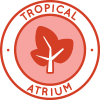




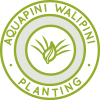






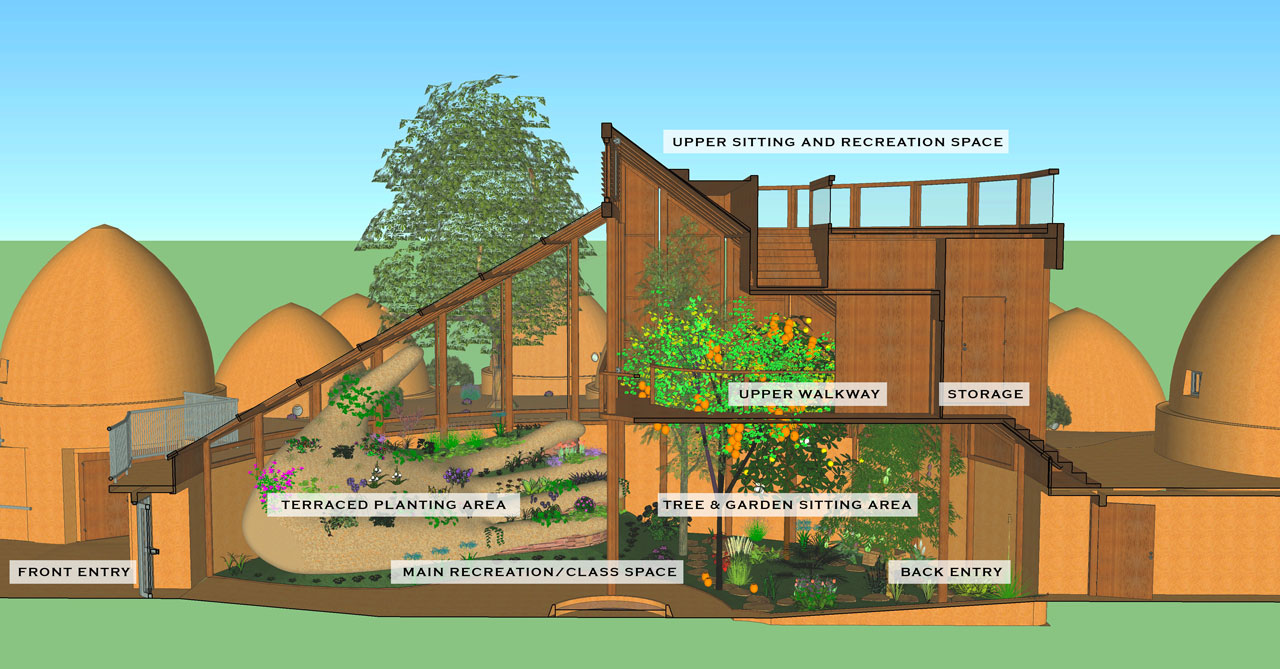
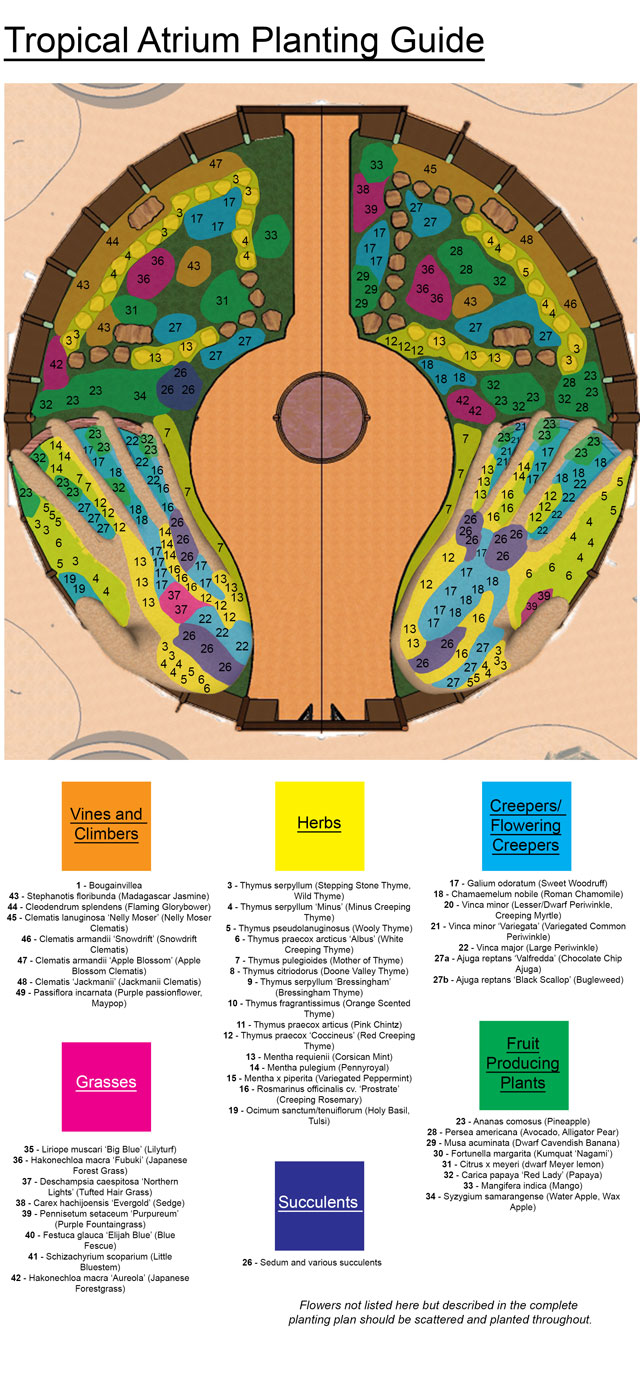
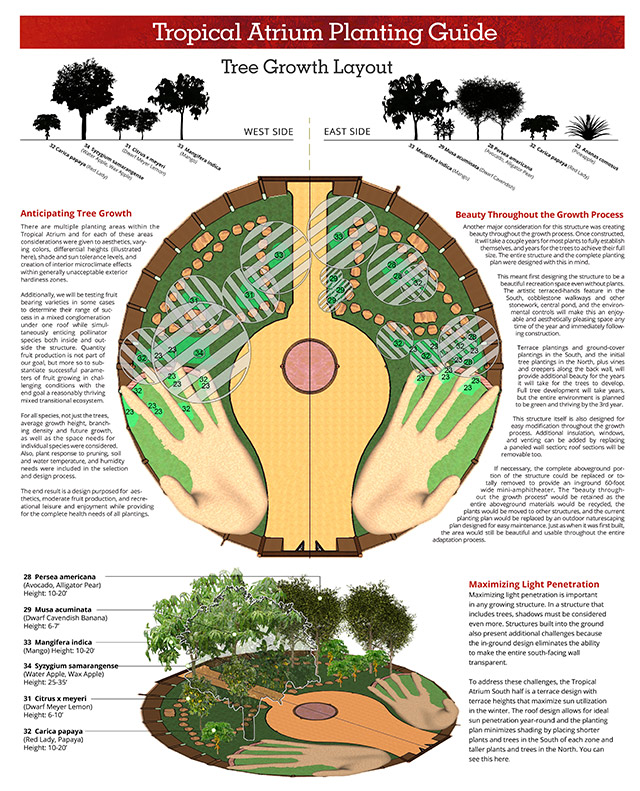
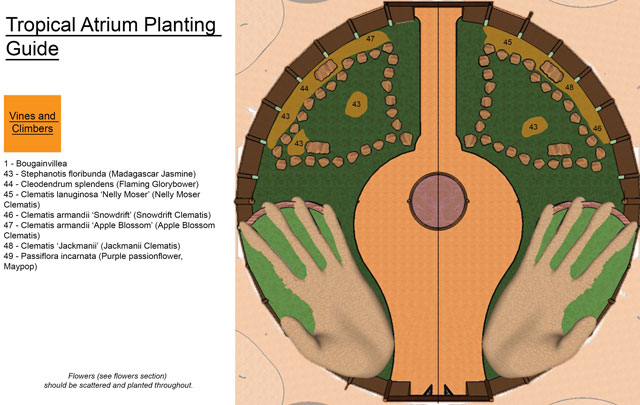
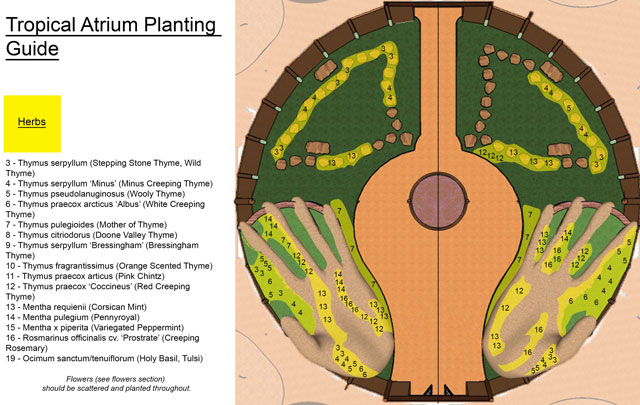
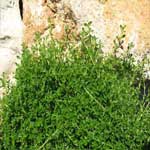
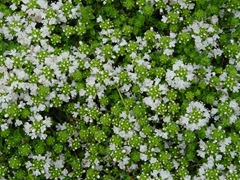
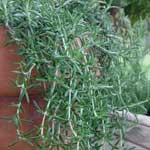
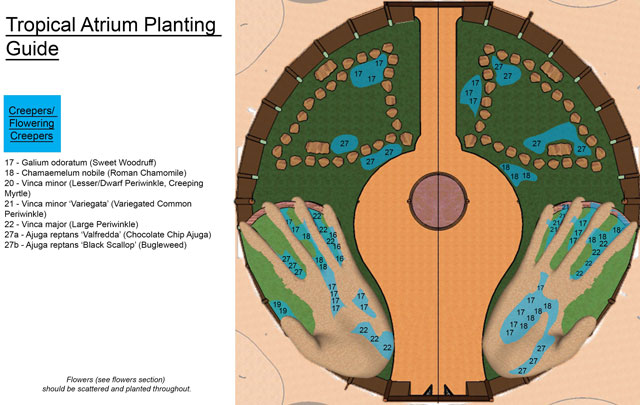
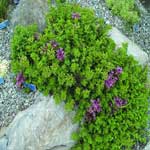
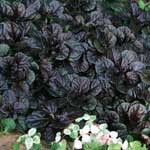
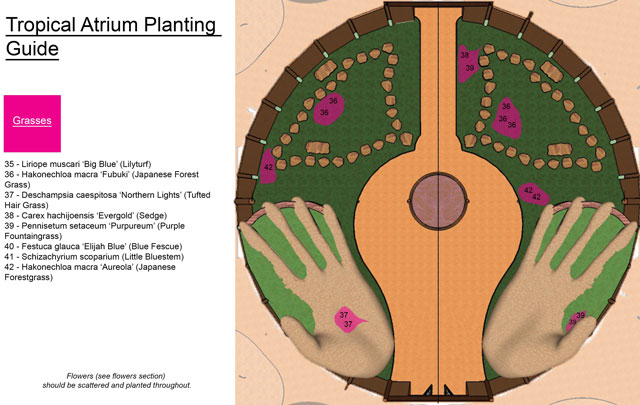
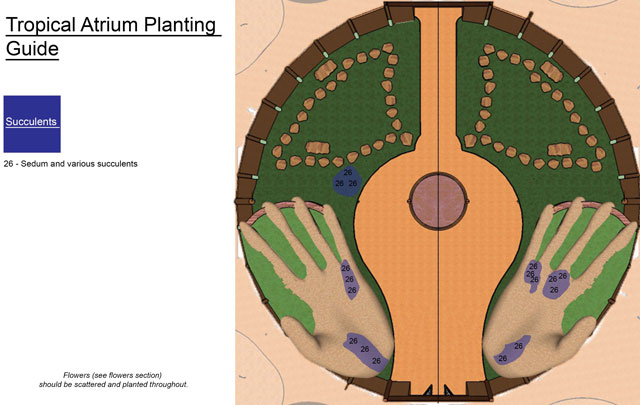
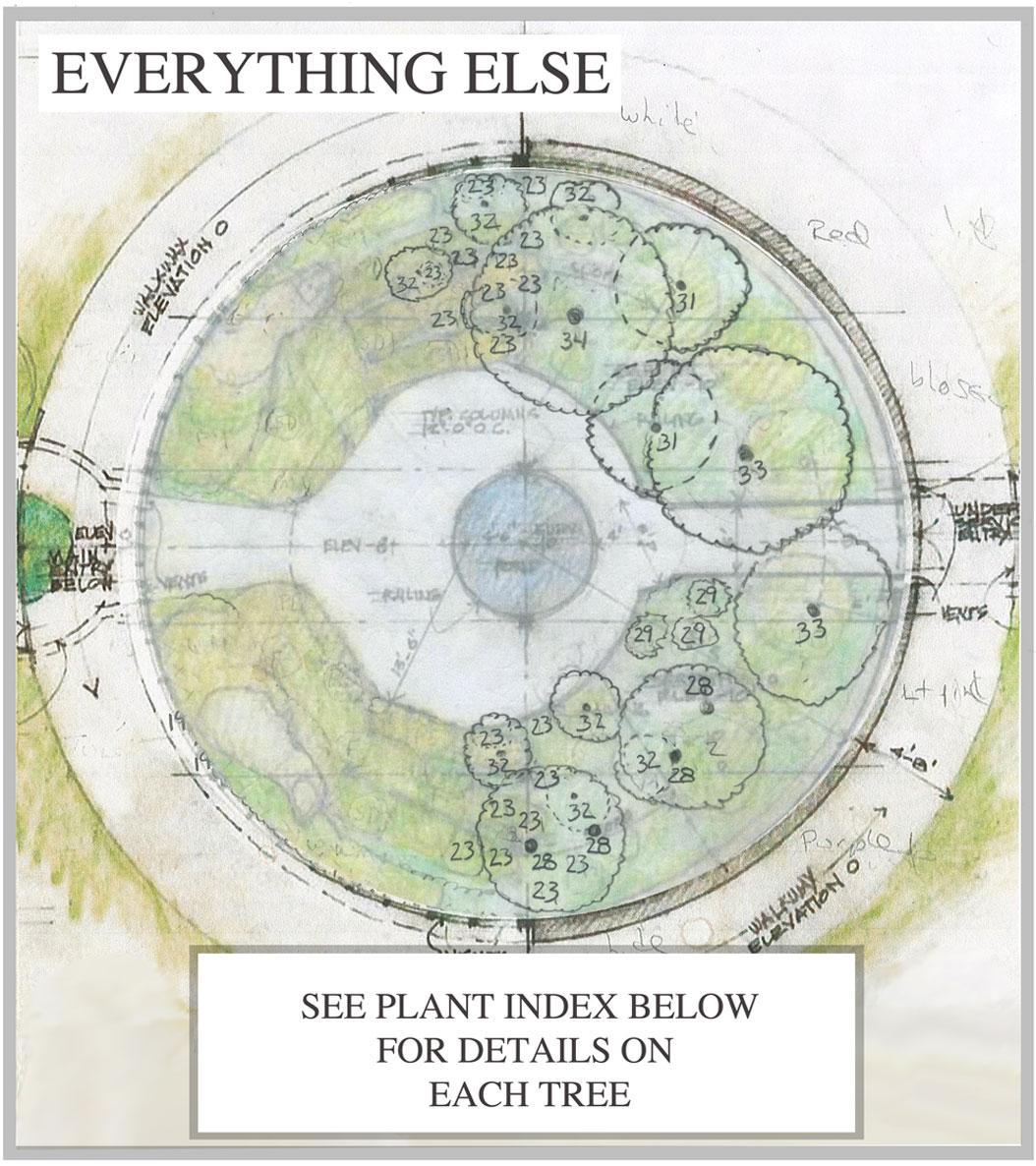
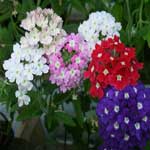




Connect with One Community